WHY WEREN’T WE READY?
LESSONS FROM HURRICANE KATRINA

HOW WE BUILD BACK BETTER




The introduction of game changing 360-degree rotating telehandlers looks set to disrupt the infrastructure, civil and construction industries
The days of needing on site a mobile crane, a boom lift or other types of elevated work platforms, a forklift and an excavator are numbered - one machine can do it all.
Rotating telehandlers may look a lot like their conventional cousins, but they are very different.
Their arrival on New Zealand work sites has completely changed the way project management is planned and the way on-
site work is completed in a safer and faster manner.
They load material, pick it up, drive to where it’s needed and then unload. The rotating telehandler can then pick the load, rotate and place the materials where needed.
The concept originated in Europe, where the majority of urban construction sites are very compact and do not allow room for traditional telehandlers.
“Rotating telehandlers have taken North Ameri-
ca by storm and over the past 18 months have been attracting a lot of attention in New Zealand,” says APS general manager Darren Boon, agents for Magni, one of the most technologically advanced brands of rotating telehandlers in the world.
“As technology has improved so has the reach and lifting capacity of these
type of machines. On a multi-level construction site, a machine with a five-tonne lift and 26-metre reach would usually have been the standard,” says Boon.
“Now machines are available for bigger projects with heavy lift capability up to 13 tonnes and machines with a reach of 51 metres.”

Magni recognised early that the biggest trend in the industry is to lift safer, higher and heavier

An Auckland private building company has purchased a Magni rotating telehandler in favour of hiring a tower crane for the construction of a four storey apartment block in West Auckland. The rotating telehandler meets most of their lifting requirements for the crane work, with a larger mobile crane only being bought in to lift the heavy pre-cast panels. Having the ability

to easily swap attachments between winch and a set of forks the machine can pick and carry around the building site for more efficient lifting or the unloading of trucks. All deliveries from the building supplier can be ordered on flat-deck trucks which means quicker delivers and savings of up to $150 per delivery by not waiting for Hiab/crane truck to become available.
The Load Movement Indicator (LMI) system is a load limit device. It is fitted as standard on all Magni telescopic handlers (RTH, TH and HTH ranges). It is made up of a rotation sensor, stabiliser cable reel, lifting cylinder pressure sensors and the LMI safety control board. Together, these components provide the operator with the best real-time load chart. This system continuously analyses the spatial positioning of the load and stores specific load charts for each attachment, displaying the correct load chart based on the machine’s working configuration.
The LMI system constantly monitors the movements of the machine to avoid any type of overload. If the system detects operating inconsistencies, it interrupts all aggravating movements, allowing only safe maneuvers (boom retraction and load release). This prevents operator error causing serious injury to themselves and nearby staff.
Every telehandler is equipped with the R.F.ID automatic attachment recognition system on the boom head. Whenever a new attachment is fitted to the machine it is recognised automatically and the display shows the corresponding load chart.
The safety of the operator and people nearby is paramount
Tech jobs are also changing rapidly and ChatGPT can actually increase productivity of coders 10 times. It is helping conversational engineers who teach chatbots to speak become exponentially more productive and it continues to be a popular topic of conversation.
Chatbots are what you see on your screens, often using a visual representation of a digital human or in a chat text box.
GPT or generative pretrained transformer is an engine that drives what chatbots say. GPT is not the only engine that does this, there are a number of very good alternatives such as BigScience Bloom, Google’s LaMDA and BERT, DeepMind models like Chincilla and AWS’s AlexaTM.

Two years ago an earlier model, GPT-3 was released by OpenAI which showed AI can write and speak with the help of a digital human.
GPT-3.5 was released in 2021 and ChatGPT in November last year. Its successor, GPT-4, is reported to be ready sometime this year. With a link up to MicrosoftAzure’s huge computing power, it’s understood to have added image capability alongside improved language capabilities.
GPT was trained on the entire internet which provided billions of question and answer pairs. This training was then optimised using a process called reinforcement learning with human feedback (RLHF).
This is a method that uses human demonstrations to guide the model toward desired behaviour. It includes things like multiple choice question and answer sets where the model’s objective is to score the most correct answers.
GPT is very upfront about
During its first few days online, more than a million people tested Artificial Intelligence software ChatGPT, generating everything from pop lyrics and trivia to articles and medical diagnoses, with sometimes dubious results, AIForumNZ executive director Madeline Newman says
its own limitations. It’s a language processor not a search engine. It hasn’t been connected to the internet since September 2021, so it can’t perform lookups and some of its data may be out of date or incorrect.
One of the main advantages of ChatGPT is its ability to generate text that is highly realistic and coherent, which can be useful in a wide range of applications
where human-like text is needed. Additionally, it can generate text in multiple languages, making it a useful tool for language-related tasks.
AI will not eat up people’s jobs but AI in today’s world works best as a partner to humans.
We are seeing lots of examples of AI helping humans to do their jobs better and make better decisions in things like health diag-
nostics.
Responsible AI is important. We are actively promoting the adoption of AI that is good for Aotearoa.
The AIForum is a part of the NZTech Alliance and brings together New Zealand’s artificial intelligence community to harness the power of AI technologies to helping New Zealand thrive.




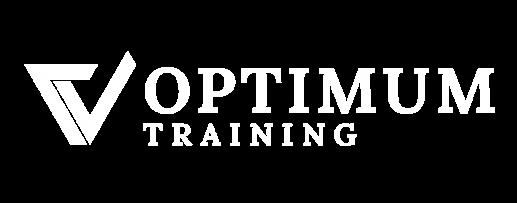

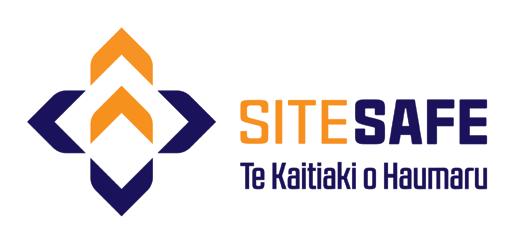


















72 Watercare goes ‘Back 2 Basics’
73 Ensuring adequate respiratory protection
75 The year that was leaves a legacy
77 Chemical safety relies on meaningful cooperation
79 Five steps for better mental health in a crisis

80 Keeping safe during flooding emergency and recovery
81 Who is eligible for the Cyclone Gabrielle recovery visa
87 The perfect combination of quality assurance, high stock levels and expertise
Editor Michael Curreen +64 21 029 20234 michael@infrastructurebuild.com


Publisher Mike Bishara +64 27 564 7779 mike@infrastructurebuild.com
Graphic Designer Rachel Loo rachel@infrastructurebuild.com
Administration Manager Anita Feria +64 27 444 1573 anita@infrastructurebuild.com

Sales Manager Margie Lindsay +64 22 317 8170 margie@infrastructurebuild.com


ISSN 2624-0572
ISSN 2624-0580 (Online)
Three Waters, resource management reforms and energy were hot topics in 2022 and will continue to be key themes in the coming year, Buddle Findlay
National Chair Jennifer Caldwell says
2022 was a busy year for the infrastructure sector. The spotlight was well and truly on the Government and its policymaking engine. We saw a steady stream of change last year, with the promise of more coming down the line in 2023.
The Three Waters reform and its layers of complexities
Despite widespread acceptance that change is needed, and the passing of the Water Services Entities Act 2022, the Three Waters reform continues to be highly controversial.

Setting politics aside, the
key pressure to successful reform now is time. It is critical that the new Water Service Entities (WSEs) hit the ground running, but with a 1 July 2024 start date for the WSEs we are running quickly out of time. While officials are working hard, there remains much to be done, with a degree
of urgency. Good policy takes time and with two bills currently before the Select Committee, and considerable implementation detail still to be developed, time is not on our side.
It will be important that councils, iwi/Māori and the DIA National
Transitional Unit (with the establishment chief executives of the WSEs) can plan with certainty. This would allow the many governance arrangements and the myriad of guidance and planning documents to be thoroughly developed. Being an election year will not make it any easier, but 2023 is the year for action if the reforms are to realise their ambition.
There has been a continued focus on the provision of national direction in the resource management space in 2022. The need for affordable and diverse housing was a key focus, with councils needing to develop and notify their intensification planning processes to enable housing supply and several housing developments utilising the fast-track consenting process pursuant to the Covid-19 recovery legislation.
In addition, we saw the commencement of the National Policy Statement (NPS) for Highly Productive Land, further discussion around the proposed NPS for Indigenous Biodiversity and further amendments to the NPS for Freshwater Management.
After much anticipation, the Natural and Built Environment and Spatial Planning bills were introduced into Parliament in November 2022 marking an important milestone in the reform of our planning and resource management system.
It is a busy and exciting start to 2023, with submissions on the bills closing on 5 February
2023. The final piece to the resource management reforms, the Climate Adaptation bill, is also anticipated this year. The reform of the Resource Management Act 1991 is a once in a generation opportunity to shape the future of our natural, built and social environment. Widespread engagement in the process is critically important to ensuring we have a system that delivers on the outcomes sought by the reform and meets the needs of New Zealand now and into the future.
Last year the Government had to take steps to reduce fuel costs and assure the public that we had enough fuel in the country.
Coincidentally, the Government was considering the country’s fuel supply resilience after Refining NZ transitioned Marsden Point Oil Refinery to an import terminal. As a result of its review, the Government announced a range of initiatives in November aimed at strengthening that resilience.

These initiatives largely adopt the Ministry of Business, Innovation and Employment’s (MBIE) policies proposed last year
of achieving onshore stock holding of 28 days’ cover for diesel and petrol and 24 days’ cover for jet fuel at normal consumption levels. The Government has not been heavy handed on this issue to limit costs to the industry and consumers. While the initiatives are an improvement on the status quo, mainly because they mandate importers (from 1 July 2024) to hold a specified amount of fuel onshore, this is only a marginal improvement as it is based on the national average of what they currently already hold (see our views about this here). However, it does mean that the Government plays a greater role in maintaining an appropriate level of fuel in New Zealand rather than leaving it to fuel suppliers –which is a good thing.
2022 has seen a sharp focus on renewable energy in the property and construction sectors, signalling the importance Aotearoa is placing on investing in sustainable infrastructure.
In particular, we have seen an increase in geothermal, wind and solar farm development projects to
aid the decarbonisation of our economy. This includes project financing structures including green loan facilities, securing land rights, commercial construction contracts, and resource management consenting processes.

We anticipate innovation within green infrastructure projects to continue in 2023 and beyond as businesses take a more targeted approach to achieving Aotearoa’s climate change and sustainability goals.
2022 saw a myriad of demands and issues facing the infrastructure sector, and we anticipate 2023 will continue to challenge participants at every stage of infrastructure development.
Aotearoa needs innovation, but with that innovation comes complexities that will challenge many industries, ultimately resulting in a more resilient and sustainable infrastructure sector.
Roughly a week after clean-up efforts began from a record-smashing deluge across the North Island, a second storm in the form of Cyclone Gabrielle is raising questions around community resilience, water infrastructure, and our wider environment
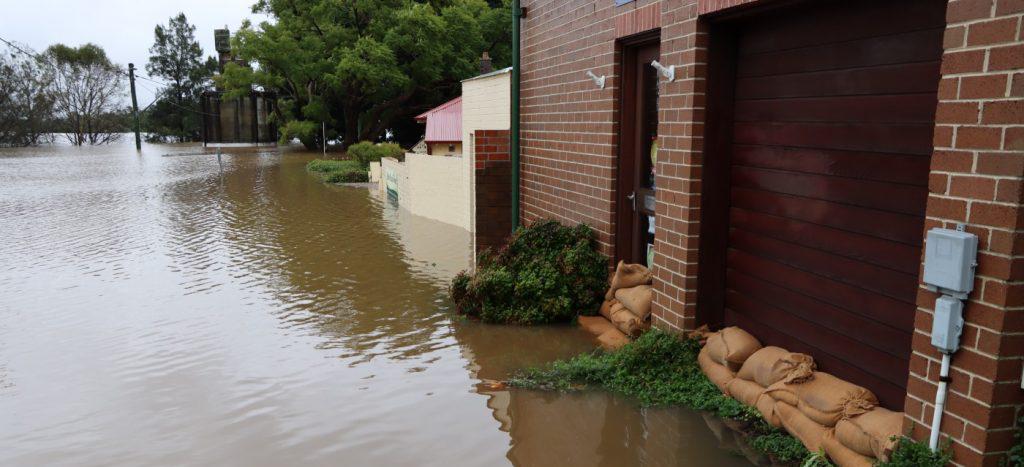
Cascading natural hazard events fuelled by climate change are the new norm for Auckland, Massey University Professor Christine Kenney says.
“Families and communities should be anticipating that cyclones, floods and other catastrophes will be occurring more frequently and planning ways to stay safe.
“Equally, local authorities should be stepping up to ensure that residents have access to essential resources and services.
“Timely accurate and regular communication with all sectors of the community regarding what and where emergency support is available and how to access it will be key.
“Outreach by local community agencies and NGOs has been very evident in response to the recent floods, yet there has been a relative silence in the media and elsewhere regarding the community assistance offered by various groups.
“As exemplars, Te Whānau o Waipareira Trust continues to provide effective outreach in West Auckland, Māori wardens have mobilised to assess needs, Te Puia Marae is still housing evacuees, and Pacifica initiatives in South Auckland have provided wide spread support in the form of meals and accommodation.
“Ensuring effective recovery from future disasters will require genuine collaboration and regular communication with these diverse
sectors of wider Auckland to ensure disaster responses are well-coordinated, resources are allocated appropriately, and all parts of the Auckland community receive essential support.”
NIWA Auckland’s Dr Annette Semadeni-Davies says the floods have shone a light on nature-based alternatives to traditional pipe-based drainage networks.
“In Auckland’s central city, land use intensification has increased surface runoff. In addition, the Auckland stormwater system is aging in places and was not designed for climate change-driven extremely high intensity rainfalls.
“The combination of extreme rainfall and limited capacity to cope with
high runoff volumes in the system led to widespread flooding.
“After the storm, there have been several recommendations for improving flood management in Auckland, including nature-based solutions. Those suggested include rain gardens, vegetated swales, living roofs and walls, infiltration strips, tree-pits, constructed ponds and wetlands.
“Such solutions are cost-effective for day-today stormwater management; their main functions are to remove contaminants from stormwater and to reduce peak flows from non-extreme high intensity rainfalls.
“They can also provide a range of social, cultural and
ecological co-benefits to urban areas, including habitat creation, passive cooling of the urban heat island, provision of walking and cycle ways, and landscaping.
“While important for protecting our urban water environments, they will not be adequate for the level of flooding we have recently seen on their own.
“It is vital to distinguish the nature-based solutions used for stormwater management from those used for flood protection, lest the public lose faith in these valuable assets if they fail to hold back flood waters.
“Nature-based solutions for flood protection, such as flood-basins, are larger than those for stormwater management. They are designed for rainfalls with a return period of decades compared to return periods of two to five years for stormwater management.
“The distinction between nature-based solutions for flood protection and stormwater management is important as the design for an effective ‘sponge’ to soak up flood waters may not be cost-effective for stormwater management and those intended for stormwater management may not have sufficient water storage for flood protection.
“Moreover, to maximize ‘sponginess’, solutions for flood management need to be ‘squeezed’ before the next rainfall, just like squeezing out water from a dish cloth before it can be used again.
“The short time between ex-tropical storm Hale and the deluge on January 27 meant that nature-based solutions based on infiltration would likely already wet because they take time to empty.
“In contrast, nature- based solutions for stormwater
management need extended storage of a day or more for water treatment, and even longer for rainwater harvesting.
“This means that a balance is required between operating nature-based solutions for water quantity control (keeping them empty between storms), water quality control (maximizing detention times for water treatment by slowly releasing water) and water reuse (retaining water for use in dry weather).
“There is also the issue
“One option is real time control of flow through pipes during high flow events (for example, by draining stormwater storage infrastructure before the onset of forecasted heavy rainfall, avoiding bottlenecks and surges, and diverting water away from critical infrastructure or densely populated areas).
“Other options include construction of underground cisterns, using existing low-risk amenities such as playing fields, parks and carparks as flood
never recover.
“The more an estuary is flooded, the more turbid it becomes, eroding ecosystem health and increasing its vulnerability to a tipping point. A tipping point is a rapid transformation that happens when an ecosystem has lost its capacity to cope with change and restore itself to balance.
“It’s vital we enact placedbased strategies and ecosystem-based management (EBM) to limit the amount of sediment and nutrients in Aotearoa’s estuaries and give them the best chance of surviving the impacts of climate-related events.”
Massey University Associate Professor Siautu Alefaio says from a pandemic to extreme weather events, compounding disasters took their toll on communities as they tried to stay resilient.
“The state of a nation prior to a disaster will determine how they recover. If as a community or nation we work together, are helpful and responsive to those displaced, poor and vulnerable.
“Have emergency management systems that align and work in unity with local community services.
of where nature-based solutions should be located. Those currently used for stormwater management in Auckland are mostly in new developments where they were part of the urban design.
“Larger nature-based solutions for flood protection, such as flood basins, will require land that may not be available and will be difficult to retrofit in the highly developed isthmus area.
“There are several options that could be explored for flood management in Auckland.

basins (there are already several examples of this in Auckland), managed retreat from vulnerable areas and continued maintenance of and upgrades to existing drainage infrastructure.”
University of Waikato professor Conrad Pilditch says Sustainable Seas research reveals an unseen cost of these events to our estuarine and coastal ecosystems.
“With much more flooding set to come in the future, these climate-related events will push estuary ecosystems to the brink of collapse and some may
“Courageous leadership that is not influenced by racism, elitist arrogance or fear of other races/cultures and how they do life.
“Basically, we are an equitable society. Then, our resilience to the severity of climates of change can withstand this new tide of compounding disasters, whether it’s you today or me tomorrow.
“The team of five million will need to empathise and mobilise in order to support each other.”

Cyclone Gabrielle has highlighted the challenges New Zealand faces grappling with the impacts of climate change, including sea level rise, changing weather intensity and storm surges. It will be both international and local insights and intelligence that guide our approach.
At the 2022 Autodesk University Conference in New Orleans, which the author attended, a panel discussed the city’s triple layered response (federal, city and community) to increasing sea level rise and storm intensity:
• The US federal government has invested significantly in surge protection mechanisms in the
Gulf of Mexico to seek to compensate for the loss of marshlands that offered natural protections to the area.
• At a city level, New Orleans, as well as investing in significant pumping capability, has been revisiting its approach and adopting system more akin to a natural catchment system using green spaces.
• At a local level, one social housing development sought to take that concept of resilience further, developing a building with great water and energy resilience.
New Orleans is protected from storm surge by a system of federally funded levees known as
the Hurricane Damage Risk Reduction System (HSDRRS). The levee system was rebuilt by the U.S. Army Corps of Engineers (USACE) in the years following Hurricane Katrina.
The 1.8 mile-long, $1.3 billion Lake Borgne Storm Surge Barrier is the largest civil-works, design-build construction project in the history of the USACE. After its construction in 2013, the Corps transferred
On the Autodesk University panel was City of New Orleans Engineer and Stormwater Program Manager Meagan Williams, whose stormwater responses were the result of her experiences as a 16 year old being affected by Hurricane Katrina. Hurricane Katrina was a destructive Category 5 Atlantic hurricane in late August 2005 that caused over 1,800 fatalities and US$125 billion in damage – the costliest tropical cyclone on record at the time as well as the fourth-most intense Atlantic hurricane on record to make landfall in mainland United States of America. Williams’ experiences prompted her to study in her chosen field of practice. It also meant she knew to sit with the people and listen to their experiences of the change and of the pinch points they experienced before designing local stormwater attenuation solutions.
Watch the video here
operation and maintenance responsibilities to the Flood Protection Authority – East.
The Surge Barrier is a complex system made of concrete and steel that is located at the intersection of the Gulf Intracoastal Waterway (GIWW) and the Mississippi River Gulf Outlet (MRGO). It includes a monolithic flood barrier of 1,071 “soldier” pilings at 140 feet in length, 26 feet above sea level, and 240 feet in length “battered” piles extending to 200 feet underground. Adjoined to the barrier wall is a 150-foot-wide sector gate, a bypass barge gate, and a 56-foot-wide vertical lift gate.
The engineering intervention is significant but even it is designed only
to prevent a 100-year storm surge from inundating the New Orleans metropolitan area.
In addition, attempts are made to have the natural systems including the power of the Mississippi River to itself build coastal wetlands again have some effect. Ironically manmade interventions through channelisation had diminished the power of these natural systems to regenerate.
The City of New Orleans had historically sought to control and manage stormwater using piped systems and pump stations,
but more recently has sought to “channel and coax” floodwaters and have them “sit for a while” using large stormwater attenuation infrastructure constructed under greenways and large road reserves that characterise parts of the city.
New Orleans is now more susceptible than ever before to hurricanes because the protection traditionally offered by the natural marshlands is being eroded.
There is less naturally occurring sediment deposited in coastal marshlands areas due to the channelised course of the Mississippi river (the levees themselves a historical flood protection mechanism) and up-river
dams.
The protective marshlands are also reported to be impacted by seawater incursion exacerbated by oil and gas pipelines and exploration and water based transport systems through canals cut across the marshlands.
Coupled with the loss of land from sea level rise generally, the future of the marshlands is concerning both ecologically, and in terms of its protective effects on human settlement in the state.
There are many displaced communities, including those indigenous populations resettled in marshland communities as part of historical resettlement initiatives where newer urban form “took the higher ground” that are having to rethink where they live.
At a local level in New Orleans residents within the city are susceptible to utility outages and one team in New Orleans developing social housing sought to also address storm resilience at a building level. They were collaborating online using Autodesk software solutions and trialled the effects of substituting more sustainable building solutions both in terms of embodied carbon and in terms of energy and stormwater management, without compromising the functionality and aesthetics of the building. Those design changes included solar capability.
Local relationships enabled them to access surplus retired electric vehicle batteries from Toyota and a local utility excited by the possibility

of stand-alone energy resilience, bridged the funding gap to enable the team to implement their solutions. That enabled designers and constructors to trial a number of alternatives including a selfsufficient building solution involving roof-mounted solar arrays.

The value of the alternative approach they took was demonstrated when subsequent power outages during Hurricane Ida took out the local networks. The buildings residents were the only city dwellers in a five block radius still enjoying the benefits of power and able to continue with their daily lives within the complex.
In a long thin largely coastal country, with a young geological form, our built environment and infrastructure has tended to be concentrated in coastal and riverine areas. Although pragmatic, that is a problem for us going forward.
We are already grappling with where to build and
what represents an appropriate response to the risks we face.
We will also need to consider whether some existing areas of settlement can, or should, continue to be protected, with managed retreat the subject of third bill in the resource management reform package expected shortly. There’s an increasing recognition that we have neither the resources nor the workforce to “engineer” our way out of the magnitude of all the problems that face us in the same way that New Orleans has with the U.S. Army Corps of Engineers USACE (being a workforce able to be deployed at scale on problems of this magnitude and even then with some limitations) and so location becomes critical.
Just as is the case in Louisiana, the role of naturally occurring wetlands and marshlands has until quite recently been poorly understood. With increasing focus on their role in both freshwater management systems and the carbon sequestration function they perform, they are also important in our response.
We too can benefit from a multi levelled approach to responding, including at a building level. The conversations around the type of structures and approaches to building that increase our resilience are already happening.
Future Stormwater management and its relationship with the built environment is complex and highly topical, with the variety of catchments even giving rise to suggestions from some that our three waters reform should instead be revised to address only potable and wastewater.
The other factor to bear in mind is that the effects are felt unevenly, both socioeconomically and culturally. NIMBYism (not in my backyard) can push social and lower value housing to suboptimal areas where the environment is less suitable for housing and the design decisions made become extremely important.
There may be a cultural cost too that is a legacy of historical settlement patterns.
It is well established that Māori pa and Urupa often sited coastally and on rivers for water accessibility are
doubly impacted by sea level rise and storm surges. As well as the physical damage, there may be a severing of connection to place and tupuna that lies at the heart of personal identity and wellbeing, with the Whakatauki, Ko au te whenua, te whenua ko au (I am the land and the land is me), speaking to the fundamental nature of those connections.
A key insight is the need to think about working with nature, rather than always trying to surmount it.
Perhaps we all need to look to history and a Pūrākau (myth) dating back to Anglo Saxon times. There is the story of Cannute or Kanute the Anglo Saxon king who reportedly commanded the sea not to advance beyond his throne placed in the path of the tide. Recent historical analysis suggests that, rather than the gesture being a manifestation of arrogance borne of his status, it was the exact opposite. He was instead demonstrating that no one, regardless of their status, can control the tides.
A salutary message perhaps for us all.
Adrienne Miller Chief Executive Urban Development Institute of New Zealand
With climate change expected to make storms intensify over time, the Science Media Centre questioned experts on what we can do to prepare our regional infrastructure and at what point we need to consider relocation or managed retreat
Professor Regan Potangaroa, Professor of Resilient and Sustainable Built Environment (Maori Engagement), Massey University:
Rural communities have unique needs and challenges that must be considered when making decisions about infrastructure development. The problem is, I don’t think that has been done.
As a committee member on the Aohanga Māori Incorporation, a coastal beef and sheep farm of 7700 hectares east of Dannevirke, I have seen first-hand the impact of extreme weather events and infrastructure decision
making. Cyclone Gabrielle caused significant damage to the roading infrastructure, loss of power and critically loss of communications. Loss of roads means that people and produce cannot move and the remoteness issues above and health issues for staff became critical.
But the crucial one has been the loss of power. That means that phones and radio transmitters can’t be charged, that electric stock fences go down and stock roam; and freezers of food, required when you cannot go down the road to Countdown or New World, are lost after 2-3 days. Communications had been cut which made it difficult to confirm whether
our staff and families were safe. Plus, the ability to assess what was happening on the farm and coordinate the allocation of resources.
For example, the committee found out via Facebook of the loss of our $1m swing bridge which effectively cuts off transport access to the southern end of our farm at Mataikona. And we are having to go back to old school ways of farming in the short term.
As a committee we are now looking at the issues of resilience through the purchase of a bulldozer, renewable energy sources, and a new bridge (once we ascertain why the first one failed). There will be definite impacts on our productivity and profitability and the
committee is taking it as a wakeup call.
What can we do to avoid constantly having to repair & rebuild the same infrastructure?
• It is important to prioritise resilience in the design and construction of new infrastructure. This means considering the potential impacts of extreme weather events, such as flooding and landslides, and building infrastructure that can withstand these conditions.
• Additionally, regular maintenance and inspections can help identify and

address issues before they become major problems.
Are there any innovations we could be using to “build back better” and improve climate resilience?
• Innovations such as renewable energy sources and green infrastructure, which uses natural features like wetlands and trees to manage stormwater and reduce the risk of flooding, can be a more sustainable and cost-effective approach to building resilience.
• Other innovations may include incorporating new materials, such as stronger and more durable concrete, and using advanced data analytics to predict and plan for extreme weather events.”
At what point do we consider relocation/ managed retreat?
• Relocation or managed retreat may be necessary in some cases when infrastructure in vulnerable areas becomes repeatedly damaged and rebuilding becomes unsustainable. However, this decision must be made carefully, with consideration of the social, economic, and cultural impacts on affected communities.
• It is important to engage with affected communities and work collaboratively to find solutions that prioritise their needs and well-being. For us at Aohanga, retreat is not an option, and you get an immediate
sense of the cultural difficulties such an approach would mean.
But the singular innovation that has to be made is a move away from a solely cost benefit-based analysis for infrastructure decision making to one where wellbeing is at the centre of that infrastructure decision making. There are several advantages to this:
1. Focus on long-term benefits: A wellbeingcentred approach prioritises long-term benefits to individuals and society, rather than just short-term economic gains. By considering the broader impacts on health, safety, and the environment, the decision-making process can lead to more sustainable infrastructure solutions.
2. Holistic perspective: A wellbeing-centred approach considers the broader impact of infrastructure decisions on various aspects of people’s lives, such as health, social connections, and access to opportunities. This helps decision-makers better understand how different infrastructure projects will impact people’s lives and make more informed decisions.
3. Inclusive decisionmaking: A wellbeingcentred approach involves engaging with communities and stakeholders to understand their needs and preferences. This ensures that
infrastructure decisions are made in a more inclusive and democratic way, with the input of all relevant parties considered.
4. Improved equity: A wellbeingcentred approach considers the impact of infrastructure decisions on different segments of the population, including marginalised and vulnerable communities. This helps ensure that infrastructure investments benefit everyone, rather than just a few privileged groups.
5. Enhanced resilience: A wellbeing-centred approach prioritises infrastructure solutions that enhance community resilience to shocks and stresses, such as natural disasters, economic downturns, and public health crises. This can help communities better withstand and recover from disruptions, leading to better outcomes for all.
In summary, a wellbeingcentred approach to infrastructure decisionmaking has the potential to lead to more sustainable, equitable, and resilient outcomes that benefit all members of society, including the rural sector. It’s a no-brainer.
It is high time that we
as a country move away from reactive responses to natural hazard events and adopt a proactive approach, to break away from the post-event “repair and rebuild” cycle.
Proactive management of infrastructure requires a commitment to understand updated risk levels as per climate change projection models, thoroughly review the ability of our lifelines infrastructure to cope, and put the necessary resources in place to upgrade vulnerable infrastructure and innovate.
Whilst there is still debate in the engineering community as to the accuracy and reliability of climate projections, Cyclone Gabrielle has illustrated the need to be diligent and cautious in making sure our infrastructure is ready for future catastrophic events in order to minimise impacts on communities.
The reconstruction and recovery effort following Cyclone Gabrielle offers an opportunity to consider necessary upgrades and changes to our infrastructure systems taking into account the advised climate projection scenarios for New Zealand in order to truly build back better.
As stipulated in the National Climate Change Risk Assessment for New Zealand report , the scenarios include a medium to low emissions pathway and a high emissions pathway, projected at different timeframes including the present, 2050, and 2100. Considering these parameters will provide guidance on the improvements needed to our infrastructure to cope better with possible future events.
It is important to note that
proactive infrastructure management also requires the acceptance of “unknown” levels of risk and considering alternative ways of improving the resilience of infrastructure, such as adopting a network approach by relying less on single infrastructure assets and improving redundancy through creating more dependable infrastructure networks.
As presented in our Build Back Better Framework and Build Back Better
Tool, upgrading our built environment to be structurally resilient is only one aspect of building back better to improve climate resilience. It is unrealistic to assume that the built environment can be solely relied upon to prevent and minimise risk to our communities.
Building back better to achieve true resilience requires a holistic approach through also considering changes to land-use, implementing effective early warning and disaster risk reduction education of stakeholders and communities, enhancing social and economic resilience of communities, and having institutional mechanisms, legislation,
and monitoring and evaluation in place that supports these activities.
Although highly disruptive, it is important to discuss options such as relocation and managed retreat with communities in high-risk areas such as our coastal areas who have been facing repeated damages from weather events.

It will become unsustainable to rely on infrastructure alone to minimise losses as hazard events continue to exacerbate in the future. Honest and open discussions about past, present and projected risks to these areas need to be had with communities in order to make collaborative decisions on ways forward. Whilst built environment and planning solutions are half the battle, long-term resilience and recovery potential of communities lie at the grass-roots level. The Cyclone Gabrielle disaster is a grave reminder that in the wake of disaster events, the first responders are always neighbours, whānau and the local community.
Therefore, in building back better it is highly important to also make genuine efforts to build resilience within communities by
finding ways to empower them with accurate knowledge on disaster and climate risk, assist with grass-roots disaster preparedness, and support the building of strong social networks.
Suzanne
Building back better is an option which allows us to consider a range of elements for recovery and reconstruction. Essentially this is a planning framework to help understand what needs to be done, and how to make it better.
Building back better asks us to consider a whole range of issues – for instance whether we should be re-building on the same piece of land. To avoid the problems of constantly having to repair & rebuild the same infrastructure after disasters, we need to use frameworks like building back better to create more resilient infrastructure.
Resilient infrastructure can withstand multi-hazard shocks and stresses and is built to last across future generations, but will cost more.
Building back better
allows us to focus on the things that matter (such as safe communities, strong infrastructure, regained livelihoods, buildable land) – the framework we developed and our book gave a full explanation of why you should use the framework and many case studies of how to create better resilience through the recovery process. The book also created indicators for recovery which can be used to track progress.
So to improve climate resilience we need to stop rebuilding in unsuitable places. If we do build in those places we need to change how we build and incorporate higher resilient features (using better materials or different parameters). We need to build above code and take a multi-hazard, intergenerational approach.
Rural and regional infrastructure is always in short supply. You can never have too much infrastructure. Small populations spread thinly present a particular challenge for local authorities and service providers.
Revenues from small populations are small, however the investment in horizontal infrastructure they need to service communities is disproportionately large. This is one of the rationales for the desire for urban densification we see in cities like Auckland. Dense populations are much more financially sustainable to provide compared to thin rural populations.
As a result, there is a strong requirement to
‘make the best’ of any infrastructure that is put in place. Roads are patched, repaired or upgraded. They are only very rarely replaced. The same is true of water supplies, bridges, drains, stormwater systems etc.
Pretty much any horizontal infrastructure you can think of has the same mantra: patch, repair, upgrade.
Roads have a particular impetus since they shape communities rather than vice versa. The existence of a road tends to drive ribbon development out of settlements. The longer the road is in service the more likely it is to remain in service –because there is now a ribbon development that needs to be supplied as well as the communities at either end.
Consider the Roman road network in Europe and North Africa. Created over several hundred years starting some 2,000 years ago. The vast majority of those roads (the routes at least) are still in effect in operation. Why?
They are dead straight and adopt the shortest viable distance between population centres. These desirable features of a route don’t tend to change. Population centres themselves tend to stay in the same place. Hence – and logically – roading infrastructure tends to follow those self-same routes. These Roman roads lasted over the years by patching, repairing and upgrading.
Bridges are a slightly different, though related, matter. Historically,
bridges tend to be built at narrow river crossings that are close to natural fords. Narrow is good because it means the bridge can be shorter. However narrow is not so good because the flow rate through the narrow part of a river tends to be higher than elsewhere – hence bridge abutments can be subject to scouring at a higher rate than elsewhere.
and continues to exercise politicians in both Auckland and Wellington. Will it need replacing? Yes. Guaranteed. When patching, repair or upgrade are no longer possible.
How is the decision made to replace such infrastructure then? Very simply this comes down to a financial decision made at the point when the cost associated with patching,
micro-generation more attractive is the way to go.
Speaking as a recent victim of rural road closure and power outages from the grid, I can tell you that having my own solar system augmented with a petrol generator makes a huge difference. Plus it takes the load and time pressure off the contractors undertaking repairs.
Sometimes it is almost like nature is constantly fighting against the needs of humans. Once a bridge is in place it links communities and there is an expectation of that bridge being there for the future. Once constructed it is hard to imagine it being removed from service.
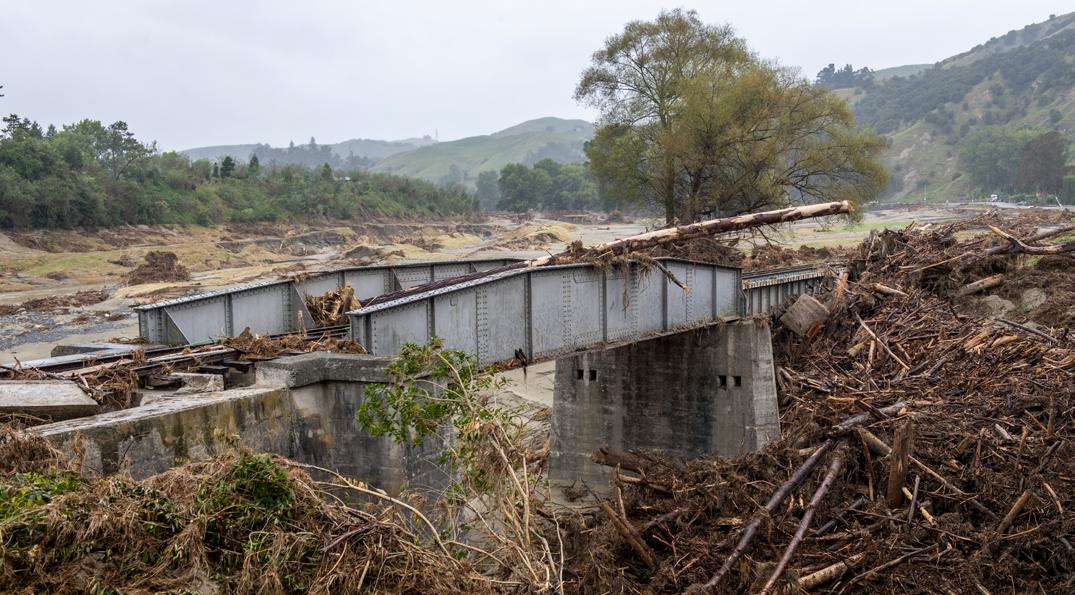
Imagine a bridge like the Auckland harbour bridge. Until it was constructed in the 1950s ferries were the norm. Now it exists there is an expectation to its continued existence. All the development on North Shore is dependent on it. Most of the economic activity on the top half of the north island crosses it at some point. What would be the value of the road system of most of North Shore without it in place? Very limited. Certainly not the motorway.
Once again bridges are subject to patching, repair or upgrade. Replacement is a tortured question
maintenance and upgrade over a period of years starts to approach the cost of replacement.
Typically it can take a number of years of escalating repair and maintenance costs before politicians finally take the plunge. Hence the continuous discussions around the future of Auckland harbour crossing ongoing for the last couple of decades.
What is the future? Infrastructure will always be in demand in one form or another. In rural communities efforts need to be made to reduce the demands being placed on highly expensive horizontal infrastructure. This can be taken by increasing the investments made in local power generation (windmills and solar in particular) to reduce the demands for power transfer infrastructure. Maybe some tax breaks or other financial incentives to make such
Insulating rural homes reduces power consumption – again another way to reduce pressure and increase resilience in affected communities. Similarly improving internet (especially satellite based) and mobile phone services means that rural communities can continue to operate remotely if required rather than rely on road access and the restoration of horizontal services.
Finally maximising the degree to which sewage and grey water can be managed and processed at a microlevel has to be a positive outcome. On the one hand investment in managing stormwater run off from housing developments reduces the amount of water that storm systems need to deal with. Hence mandating and subsidising grey water holding tanks can reduce the effects of storm water surges – so likely should be subsidised.
On the other hand, septic tanks are all well and good, however increasing onsite processing in reactors can improve the quality of water heading into the environment and reduce the effects of storm events. Once again some subsidies may be helpful to make this a more common solution for homeowners.
Water capture and storage is a proven way to reduce the destructive effects of flooding by regulating the water flow and volume into vulnerable areas. Drawing on water from storage also supports food production. The more volatility in the climate, the more we need resilience in water infrastructure.
The reform of New Zealand’s Resource Management Act (RMA) gives us an opportunity to prioritise water infrastructure as part of our climate change response.
At a time when a changing climate poses such significant risk to lives and livelihoods, when food affordability – particularly fresh fruit and vegetables is really biting – practical, long term water management should be considered critical to New Zealand’s future and enabled by the legislation which replaces the RMA.
Unfortunately in its current reading, the Natural and Built Environment Bill (NBEB), which is proposed as the replacement to the RMA, does quite the opposite and stymies this critical infrastructure development.
The NBEB proposes to truncate water consents to a maximum of 10 years for all users which disincentives investment in water capture and storage infrastructure and makes it uninsurable and hard to finance. This also impacts our ability to increase local hydro generation and reliable drinking water supplies.
We urge the Government to ensure the resource management reform enables development of regional water infrastructure and that there is a consenting pathway to reflect its national significance for the wellbeing of our com-
Recent flooding in the North Island has decimated huge crops of fruit and vegetables, demonstrating the need for New Zealand to better mitigate the impacts of climate change – water management is a significant part of this, IrrigationNZ Chief Executive Vanessa Winning says
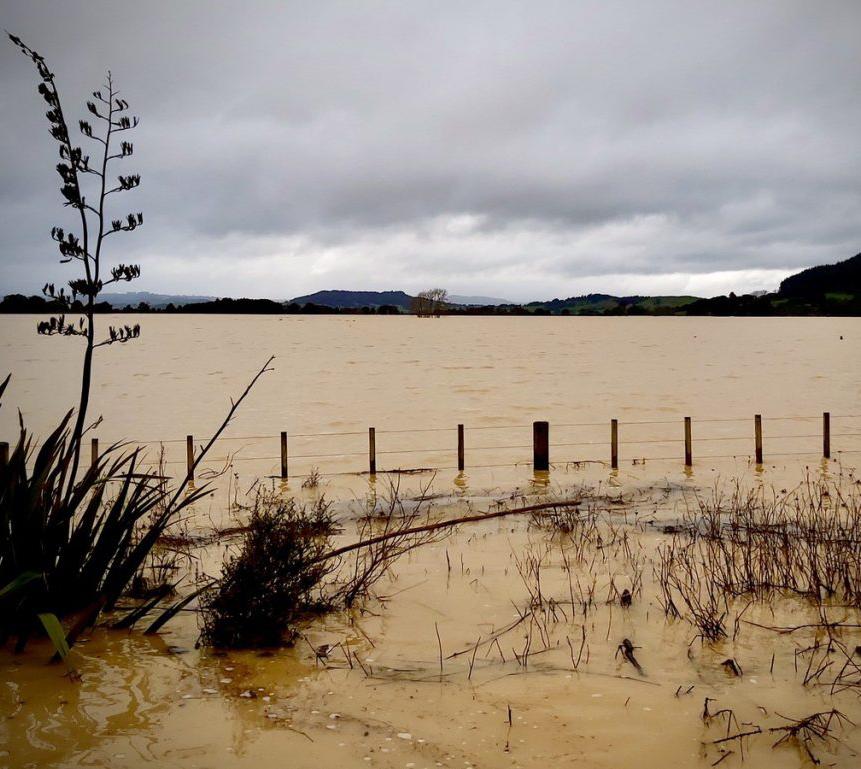
munities, environment and economy.
The NBEB as currently drafted also creates more compliance, more restrictions and more uncertainty for water users who rely on available water to grow our food, in particular fruit and
vegetables, viticulture and crops. The NBEB needs to provide certainty, reliability and flexibility to our food growers at a time when we need them most.
This is some of the most important legislation and law to be formed in a
generation. It significantly impacts every part of New Zealand – let us use this opportunity to get it right.
The old RMA is broken, but the new legislation puts even more distance between communities and decisionmakers, says Local Government New Zealand President Stuart Crosby

There are grave concerns that councils will lose their power to make the best planning decisions for their community under the new resource management system.

At the heart of the reform lies the establishment of 15 Regional Planning Committees (RPCs). They will be charged with developing the plans that shape what our communities look and feel like.
RPCs will be able to make decisions independently from councils. This represents a fundamental change to local councils’ roles and responsibilities, and does not guarantee a simpler, more affordable system.
RPCs will be made up of representatives from local government, iwi/hapū. There will be a central government representative involved in regional spatial planning. The exact makeup of the committees will be decided at a regional level, requiring at least 6 members in total with a minimum of one member from each council in that given region. At least two members of the committee will be appointed by Māori appointing bodies.
There are concerns about whether individual com-
munities will be strongly represented on the RPCs, how RPCs and their support staff will be funded and whether the work councils have done on existing planning documents, like regional and district plans, will feed into the new system.
The new system needs to
protect our environment and help us build resilient, great places to live. That becomes very difficult when communities can no longer hold elected members to account for decisions that impact their neighbourhoods.
We can’t have a scenario where the voices of those
living in Masterton for instance, won’t be heard amongst the louder ones that have a larger population such as Wellington.
These are once in a generation changes, the Government needs to take the time to get them right.
Local government agrees how we deliver three waters services to New Zealanders must change. Broader system failure has created longstanding issues, negatively affecting many communities now and even more in the future. Climate change-related extreme weather events will continue to compound that impact on communities’ wellbeing, as we have seen in recent floods.
While all our members want better outcomes for communities through three waters reform, they are not unified in their views on the Government’s model.
Nevertheless, the Government’s model and approach can be improved in response to local government’s commonly held concerns. If this legislation is implemented, we want it to be as workable as possible.
As three waters reform shifts from design to implementation, councils need certainty that their relationship with a Water Services Entity (WSE) will support and enable council functions, placing communities first.
Councils are much more than just another three waters stakeholder. The proposed relationship agreement will be critical to the relationship between councils and the water services entities – and its current framing fails to acknowledge that relationship’s criticality and complexity.
Councils are already stretched responding to other reform and frequent emergency management events. We are concerned
Three waters reform threatens councils’ vital role as leaders in placemaking and community wellbeing outcomes, Local Government New Zealand (LGNZ) says in its submission on the Water Services Legislation Bill and Water Services Economic Efficiency and Consumer Protection Bill
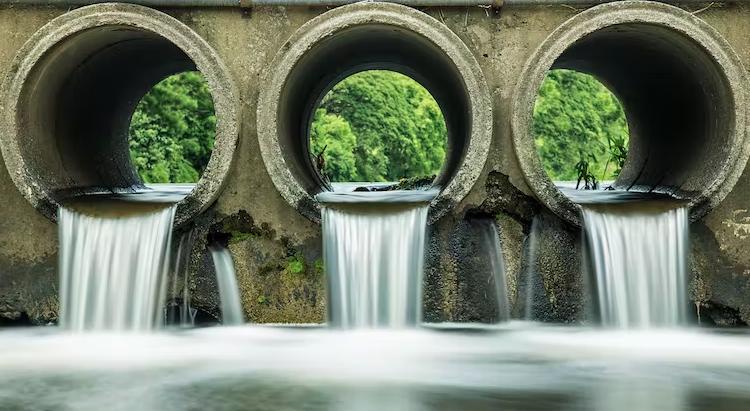
about the practical implications of transfer provisions set out in the WSEA and the WSLB, including how much council resource these could consume on top of councils’ BAU work. Some councils are
“mixed shareholder CCO” for the purpose of the WSEA. This even includes CCOs where the provision of water services is not their primary or predominant business.
Many councils are strongly
shocked that council-controlled organisations (CCOs) now appear to be captured by reform. We are surprised and concerned by the number and type of council organisations (including CCOs and their subsidiaries) that would be treated as a “local government organisation” or a
against collecting water charges on behalf of WSEs.
There is too much uncertainty around the charging regime (including the scope of geographic averaging). This includes the need for limits/regulations on the charges that a receiver will be able to collect in respect of unpaid debt of a WSE.
concerns with the Water Services Economic Efficiency and Consumer Protection Bill (referred to as the Economic Regulation Bill)
The core problem definition is wrong. It approaches the water services sector as if it was any other natural monopoly utility. We find the reference to WSEs’ ability to “extract excessive profits” inflammatory and inaccurate.
Information disclosure should be the primary focus for economic regulation, at least initially.
Implementing quality regulation and price-quality regulation in the first regulatory period doesn’t make sense.
Read LGNZ’s full submission
The National Party says it will scrap the Government’s Three Waters Reforms, but its alternative plan just puts more pressure on already struggling councils
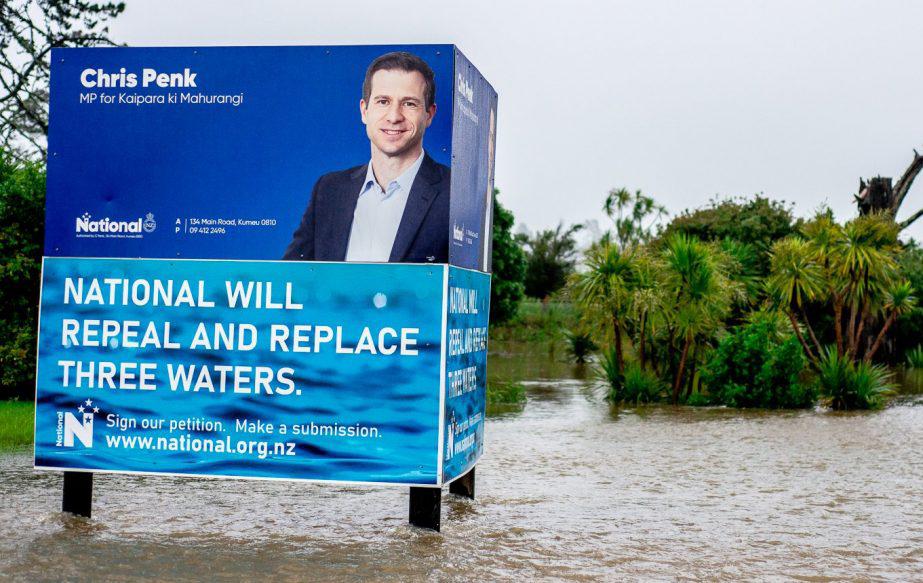
Boil water notices, e-coli alerts at beaches and inadequate stormwater infrastructure — there is no question that the way water services are managed in this country need to change.
The Government’s answer to these problems is to give control of the country’s water assets to four entities made up of Local Government representatives and iwi, with councils still retaining ownership of those assets.
The National Party opposes this model and has released its Local Water Done Well policy document which will keep water assets managed by local councils. The catch is that councils must prove they can make their water services financially sustainable, otherwise Central Government will have the power to step in.
With many councils already struggling to provide sufficient water services, yet alone a service that is financially sustainable, Central Government intervention seems almost unavoidable under this model — a model where its whole selling point is keeping councils in control of their water assets.
The issue is and always has been funding — many councils do not have the capital to invest in their
water infrastructure to get it up to standard. Unfortunately, National’s policy barely addresses this, only going as far as saying it will support “greater access for councils to long-term borrowing” and that “councils could choose to implement volumetric water charging, charges for new connections, or have water service costs included within rates. This approach allows councils to tailor their settings to their community and ratepayers.”
In other words, more debt and higher rates.
When that is not enough, only then will Central Government even consider coming to the party, the policy says.
“Where the Government concludes that a council
cannot achieve financial sustainability by, for example, gaining access to long-term borrowing, it will provide limited one-off funding to bridge the gap.
“Support will be determined on a case-by-case basis. Crown funding will not be used for the dayto-day delivery of water services, but only for projects needed to transition to a sustainable footing. National believes that restoring local control also means restoring local long-term investment responsibility.”
The policy makes it clear National does not trust councils to manage their finances and will require them to ringfence money for water infrastructure and not spend it on other services instead.
National says the way councils approach this is entirely up to them, but to be financially sustainable, it expects councils will have to work together to form bigger water entities anyway.
“We expect a number of councils will choose to form a Regional CCO, but National will not be mandating it, or
any other model. If councils can demonstrate an alternative that complies with regulations for both water quality and water infrastructure, and is financially sustainable, National will approve it.”
Essentially it is still amalgamation, but for many ratepayers, at a far greater cost.
Clean drinking water and effective sewage disposal (sanitation) is fundamental to public health, so much so that we take them for granted. That is why the Havelock North campylobacter outbreak in August 2016 was such a shock.
It was caused by surface water contaminated with sheep faeces entering the untreated drinking water system, resulting in an estimated 8320 infections, 58 hospitalisations, and at least four deaths, making it the largest campylobacter outbreak ever reported.
The subsequent Havelock North Drinking Water Inquiry recommended a major overhaul of drinking water supply in New Zealand, which was subsequently broadened into the Three Waters Reform Programme.
Debate around the proposed Three Waters reforms has mostly focused on anti-cogovernance arguments, and concerns around the loss of local control of water infrastructure. This has overshadowed the original reason for the reforms, one
Whatever new system we adopt, public health and environmental needs have to be kept as a central focus to reduce the risk of another crisis like the Havelock North campylobacter outbreak, University of Otago Professor Michael Baker says

of which is to ensure safe, good quality drinking water is available for all.
There are multiple public health and environmental problems and threats that these reforms need to address, in addition to reducing the risk of a repeat Havelock North outbreak:
• Regular microbial contamination of drinking water systems, particularly following floods which are becoming more common with climate disruption, resulting in frequent breaches of the drinking water standards and boil water notices.
• Concerns about intensified farming and increasing microbial contamination of source water, including with protozoa (cryptosporidia and giardia) which are harder to remove from drinking water with conventional methods.
• Increasing levels of nitrate contamination of drinking water, particularly in intensively farmed
areas, from application of nitrate fertiliser and urine from cattle.
• Problems with monitoring of fluoride levels, as seen in Wellington, and potentially an issue in other supply systems.
• Concerns over lead contamination of drinking water, as seen in Dunedin, and potentially in other water distribution zones.
• Inequalities in access to clean drinking water with smaller rural and more deprived communities having poorer access.
• Wider environmental issues, including sedimentation, and nutrient, bacterial, and heavy metal contamination of freshwater and coastal areas which causes direct ecosystem damage, and potential human health effects.
Whatever new regulatory and deliver system we adopt, it will be important that these public health and environmental needs are kept as a central focus.
The Havelock North
Drinking Water Inquiry emphasises the need for a highly systematic approach to improving the quality and safety of drinking water. A similar need applies to wastewater and stormwater management.
The first part of the water reforms has already been operating for a year. Taumata Arowai became New Zealand’s dedicated regulator of drinking water when the Water Services Act came into effect on 15 November 2021.
It published a Statement of Intent for 2022 – 2026. Key outputs we can expect from this agency are a comprehensive monitoring system of drinking water quality, and drinking water standards that incorporate the best scientific evidence we have about the health effects of contaminants such as nitrates.
There will need to be a strong focus on addressing major upstream risks to the safety of drinking water supplies, such as increased intensification of pastoral farming and climate disruption.
Introduced in March 2022 as a temporary threemonth measure, the Government has once again extended its “cost of living support” until 30 June 2023 as the cost of living crisis continues. Included in this support package is a 25 cents per litre petrol excise duty cut, discount to Road User Charges and half price public transport fares. While the action on public transport has been welcomed by other parties, they have been less supportive of the policy’s other measures.
National would not go as
far as opposing the policy but did wonder where the money would come from after Finance Minister Grant Robertson said just last month that an extension to the policy would be unaffordable.
The ACT party was more upfront about its views on the policy, with Leader David Seymour calling it “totally incoherent”.
“Reducing revenue while spending up large is Liz Truss-style economics.
“Petrol taxes are hypothecated for road building and maintenance. Anyone who has spent

more than a few hours on our roads over the summer will have noticed they’re in desperate need of repair. When petrol taxes get cut the money has to come from somewhere else.
“The Government has decided that all taxpayers will pay for motorists to have temporarily cheaper petrol.”
Fuel prices are now well below where they were a year ago, Seymour says.
“Now is the time to rip the band aid off.”
READ MORE: Fuel tax cut a wasted opportunity
Economist Brad Olsensays that extending the fuel subsidy gives three times as much help to the top income decile compared to the bottom income decile.
“It’s terribly regressive,” Seymour says.
The Green Party agrees, with co-leader and climate change spokesperson James Shaw saying subsidising petrol for everyone, including the highest income earners, is not the answer.
“A fuel tax cut is very poorly targeted. The impact of inflation is not felt equally. It is people living on the lowest incomes who are
While the cost of living and climate crises continue to bite and New Zealand’s transport infrastructure falls into disrepair, the left and right are both criticising Labour’s fourth extension to its inflationary fuel tax cut, calling it “dumb, election year populism”
hit the hardest. And yet, it is the top earners who benefit most from petrol subsidies.”
Both parties had other solutions in mind.
ACT proposes a return of the proceeds of the Emissions Trading Scheme to citizens, which would give families a sizeable refund without reducing a cent from the roading budget.

“ACT’s policy has the advantage of being sustainable, while maintaining the incentive to emit less carbon,” Seymour says.
“A family that used its carbon tax refund for greener solutions would effectively be subsidised by those who buy petrol.”


Shaw wants to provide direct payments to lowincome households by increasing Working for Families and the Accommodation Supplement.
Either way, the subsidy is a poor use of the transport budget, he says.
“The money spent on a fuel tax cut would be far better spent making half-price public transport permanent, along with sustained and permanent investment in more reliable and efficient public transport infrastructure.
“Subsidising fuel costs more than $1.3 billion per year. With Auckland’s transport infrastructure damaged so badly from climate-fuelled flooding, now is not the time to be short-changing our transport budget. Auckland has just experienced first-hand the devastating impacts of climate change. It just doesn’t make sense to be extending subsidies for fossil fuels.”
In recent years, many countries have turned to private finance as a means of funding infrastructure because often, the private sector is best placed to mobilise substantial funding within short time frames. The most common model is the Public Private Partnership (PPP).
Given the high volume of transactions and relatively straightforward construction profile, compared to say a rail system, toll roads have become an asset where the PPP model has been used extensively. Generally, a private concession company is paid by a government to design, build, finance, operate, and maintain a road to a certain standard over a period of decades.
In cases where the operator keeps the tolling revenue, this is used to pay off the finance incurred and the cost of maintenance. If the tolls revert to the government, the letting body typically pays the operator for capital cost,

finance charges, and maintenance in a series of lump payments, commonly known as “availability payments” which are, as the term implies, paid to the operator for making the asset available. At the end of the agreed concession period the state reclaims ownership of the asset or re-lets it to the market.
As they do not involve a large outlay of public capital to build, and place
performance risk back onto the asset provider, PPPs are well regarded by multilateral institutions and commercial lenders alike. The PPP model only works effectively, however, if specific risks are borne by the party best able to manage them.
If a risk, for example labour cost risk, is not allocated or indexed correctly, then a project has a higher risk of failure either
during construction or once operational. In some cases, it may not even come to fruition due to being unable to raise sufficient funding.
What usually causes a project to fail is the public sector placing excessive risk onto the private sector. If this happens, one of two outcomes usually occurs.
Firstly, the private sector cannot accept the bundle of risks and the project never gets off the ground.
As recession bites, cash-strapped nations will need private finance to fund new projects, however the public private partnership model only works if specific risks are borne by the party best able to manage them
Secondly, an overly ambitious private sector entity will take on the excess risk, and once hurdles are encountered, for example a fuel price spike, the project will fold. In the former case the economy is left without a market driver. In the latter case, often everybody loses money.
Cash-strapped Asian emerging market governments often lack the funds to build the largescale infrastructure projects which underpin sustained economic prosperity.
Due to skills shortages, currency risk on imported equipment, and procurement capability, countries in emerging economies often struggle to package and deliver a successful PPP.
Project sponsors in emerging Asian nations can lower the risk of project failure by examining what went wrong in other countries at a similar stage in their development cycle, and by allocating risk appropriately.
When undertaking a post-mortem on many toll road disasters it is usually possible to find one of three causes for their demise.

PPPs are tailor-made and as such require experienced experts who understand the intricacies of such projects from a legal, financial, and technical perspective. It is almost impossible to assemble a team of experts covering all areas of required expertise in-house. The procuring entity therefore has to be willing and able to spend substantial amounts of funds on external experts
rather than taking it on itself to develop and negotiate a project.
Successful contracts, however, can be replicated and refined over time. A successful example are the German A-Model projects where the concession contract of the first A-Model, the A8 between Ulm and Augsburg, became the template for the government’s programme and was further refined over the years to come. A key refinement was the switch from usage risk to Asset availability
making some reasonable profit in return.
Risk sharing can be considered wherein the government guarantees certain revenues but shares in upsides exceeding certain thresholds: often referred to as “cap and collar”. Similar to availability payments, these schemes are equally palatable to investors and lenders alike, whilst at the same time shielding the government from excessive risk exposure.
Risk sheltering can also be temporal in nature. A
The private sector requires certain commitments from the government such as guaranteed increase of user-charges over the years and contractual assurance that the government will not discriminate against the project.
Moreover, risk needs to be hard-wired into a PPP contract to account for market inflation. For example current toll road concessions in France include indexing provisions linked to inflation for the construction price between today and when construction begins, to reflect the significant uncertainty at the present over how prices are evolving.
payments following the Global Financial Crisis –this is an excellent example of learning to adapt risk allocation as circumstances evolve.
An overly ambitious project which incurs too much capital expenditure, or is at high risk of cost overrun, will find no private sector uptake – the private sector has to be able to recover its costs while
good example was the DLR Lewisham Extension where the first half of the concession consisted of availability payments to shelter the concessionaire from usage risk as employment at Canary Wharf rapidly increased; once this new major employment expansion area for the city of London had developed, the contract shifted to usage-based payment
Managing these issues is key to the successful implementation of crucial infrastructure which can lift up entire markets and impact generations in the future. But it’s important to study where PPPs went wrong to ensure a project is successfully delivered. Often it is necessary to listen to the wisdom of Confucius: “A person who has committed a mistake and doesn’t correct it is committing another mistake”.
Contributors:
Dave Ashmore is Associate Director in Oxford Economics’ Transactions Advisory Business
Philip Bates is Director of PDBConsult Ltd
Martina Dampf is Business Development Director at TYLin, Philippines
While there are some projects New Zealand can deliver just as well as other high-income countries, it does struggle when it comes to bigger projects, a report from Te Waihanga / The New Zealand Infrastructure Commission finds

The lay of the land: Benchmarking New Zealand’s infrastructure delivery costs provides a comparison of New Zealand’s infrastructure delivery costs compared to other high-income countries.
This report is timely as we start to face up to the reality of a combined infrastructure deficit costing around $210 billion to plug.
Funding this gap will be challenging but we also need to ensure we are building good infrastructure at an affordable price.
The results of this assessment do shine a spotlight on a number of project types in which we are really struggling to achieve cost effectiveness.
Complex large-scale infrastructure projects are often drawing a cost premium for a number of reasons. It is important we learn from these assessments and start to address some of the system issues identified. Lessons from the recent Infrastructure Australia review (also discussed in this InfraRead edition) are indeed relevant.
What projects do we do as well as other countries?
In summary, four types of infrastructure projects: surface rail stations, electricity transmission lines, on-shore wind farms and hospitals
are all delivered within similar cost ranges as those in other countries we are compared with.
Our big issues are with complex, and larger one off type projects such as some urban and rural motorways, road tunnels, and under-
3. Physical environment – differences in physical context – factors like geology, climate, and built environment – can increase the cost to build infrastructure in some places.
4. Policy and institutions –factors like project sponsor decision-making, infrastructure design standards, planning and consenting systems, and procurement
pipeline is bedded in fully and there is more certainty across the sector as to the ongoing work. The challenge of our often unique physical environment is not so easy to remedy and often this is an area where we need to draw on more innovative approaches and be open to new construction techniques.
It was excellent to see Te Waihanga be invited by the UK Institute for Civil Engineers (ICE) to present their benchmarking findings to an expert via a Zoom Presidential roundtable session. This international engagement session also gave the opportunity to tap overseas perspective on some further insights and possible solutions to explore.
ground rail projects. There is not just one simple reason for the higher costs of these projects. Te Waihanga have identified four broad reasons why the cost of similar infrastructure projects might vary between countries:
1. Input costs – labour, materials, equipment, and land – might be higher in some places.
2. Construction productivity – may be higher in some places, allowing them to build more infrastructure using the same quantity of inputs.
and contract models – can increase scope requirements and thus increase costs.
I’m sure we are all expecting the current resource management reforms to address some of the planning delays and associated cost issues currently faced by all infrastructure projects in New Zealand, particularly when compared with the other countries covered in this benchmarking study. We also wonder if input costs and construction productivity can be improved as our infrastructure
Much of the advice offered, aligned with recommendations already identified in Rautaki Hanganga o Aotearoa, the 30 year infrastructure strategy. But hearing others’ experiences and lessons first hand really brings to life the value of collective knowledge.
It was a fascinating exchange with many suggestions as to what changes might make a difference and what other considerations could be taken into account, you can read a summary here.
In an effort to combat rising construction costs and lengthy project times, applying non-linear workflows would mean different stages of work could be done simultaneously
Non-linear workflows have become part and parcel of the media industry given the nature of the sector. With work completed in segments, content can be created, edited and post-produced in parts throughout the lifetime of the project.

Replicating this type of process in the engineering and construction realm is dependent on various elements. Traditionally, complexities underscoring construction contracts and the liabilities that come with those often inhibited that sort of mesh.
If we look at fidelity, concept and detail design conducted by an architect is passed onto engineering, which is then forced to remodel, and once it reaches construction, there’s often a need for revision to bring a building to life. Liability increases as it moves through the chain.
Consider the apartment blocks in the Sydney suburb of Mascot which were reported to have flaws – an unclear workflow culminated in major issues for those towers.
But it’s certainly not impossible to converge non-linear practices across specific stages of engineering and construction.
For example, there is opportunity to blend transition points to create more efficiency, helping overcome data loss and preventing
rework, symptoms that result in project timelines and costs blowing out. We see that happening in highway projects where the work is segmented into sections that run simultaneously. There are, however, still questions – and uncertainties – around whether breaking up projects can be done non-consequentially. The reality is you can’t easily reconstruct the last seven kilometres of a highway like you can reshoot a few scenes of a film.
Technology advancements are making things easier, though. Using the industrial metaverse, for example, allows engineering and construction companies to quickly and efficiently modify designs at any phase before a build commences.
Projects are no longer just visualised through CAD, but can be ‘experienced’ to
completion before building even starts. Combined with a foundation created through building information management (BIM) and ever-expanding digital twin capabilities, far more variables can be analysed for effectiveness, and issues ironed so that once it’s time to get the tools out, the work is optimised.
Ultimately, it’s crucial nothing in construction happens in isolation. Information and collaboration can’t be siloed, and project teams must remain connected with constant access to critical project documentation and data. Breaking down barriers between the various stages of a build not only reduces time and costs, but fosters assurances through visibility so nothing needs to be pulled apart after physical materials are put together.
Andy Cunningham, Senior Regional Director Australia and New Zealand at Autodesk
Autodesk technology spans architecture, engineering, construction, product design, manufacturing, media and entertainment
autodesk.com
W i t h y o u r s u p p o r t w e c a n c o n t i n u e t o p r o v i d e p ra c t i c a l h e l p , c a r e a n d c o m f o r t .
A c c o m m o d a t i o n a n d h o m e v i s i t s a r e j u s t t w o o f t h e w a y s w e s u p p o r t N e w Z e a l a n d e r s a f f e c t e d b y c a n c e r.


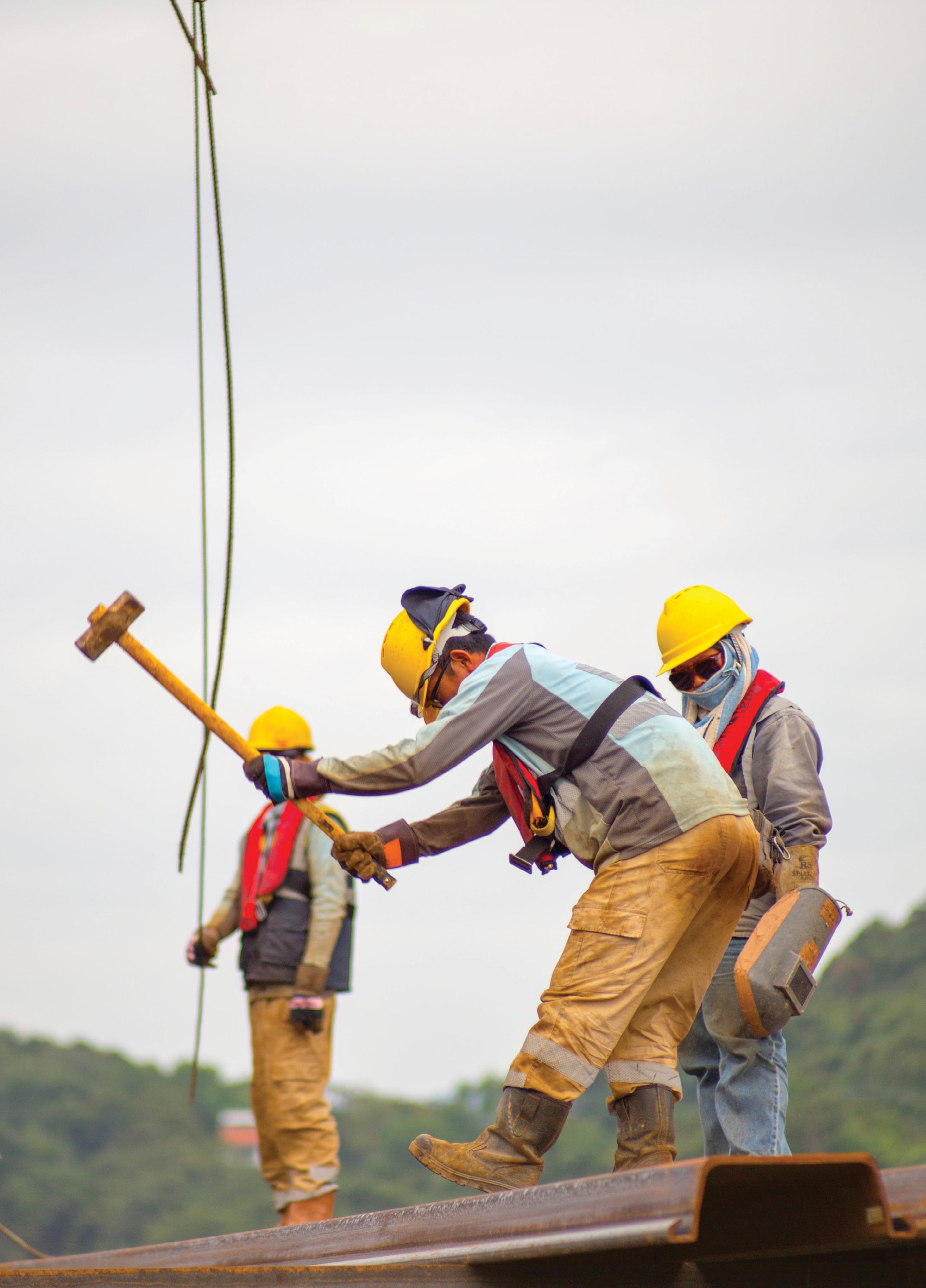

We're proud that more than 6300 members trust us to be a guiding influence in creating a positive change in the health and safety culture of New Zealand's construction and wider industries.
Our members are in excellent hands. Their annual membership fee gives them access to a trove of exclusive industryprepared best practice guides, tools, research and other helpful health and safety content.
It also gives them exclusive access to a vast range of discounts from well-known suppliers and big monthly promotions.
No matter the size of your organisation, choosing to be a Site Safe member will provide you with industryleading health and safety guidance across New Zealand.
Skilled and qualified in a variety of areas and industries, our Safety, Health, and Environmental Advisors provide expert consultancy, auditing, training and general assistance for your business.
So if you're dedicated to workplace accident reduction and raising health and safety awareness, becoming a Site Safe member may be the move you're looking for.
•10% discount in your first year of membership, increasing up to 30% in your fifth year
•Instant recognition from the industry of your commitment to health and safety
•Networking opportunities at Site Safe member events
•Yearly certificates, stickers and posters
As one of New Zealand's leading health and safety notfor-profit organisations, Site Safe prides itself on its ability to empower and build safer and healthier workplaces across the country.
 By Communications Advisor Jonathan Guildford
By Communications Advisor Jonathan Guildford
•Keep up to date on big moves in the health and safety space with our exclusive newsletters
•Access to more than 50 exclusive Toolbox Talks for you to download
•Use of the Site Safe member brand for marketing and promotion of your business
•Book and pay for your training online
•Easily view your upcoming courses
•Purchase products online
•View past transactions with Site Safe online booking
We also partner with Trade Associations to provide additional benefits to their members and opportunities to promote
upcoming conferences and events through Site Safe's communication channels.
If you are a member of one of our partnered Trade Associations, you will receive a 10 per cent discount on your annual Site Safe membership fees.
If you'd like to see how being a Site Safe member can benefit your businesses health and safety goals, head to the membership tab on the Site Safe website at: https://www.sitesafe. org.nz/memberships/joinus/
Site Safe is a national not-for-profit membership organisation.
Since forming in 1999, it
has been a driving force for creating a positive change in the health and safety culture of New Zealand's construction and wider industries.
Our organisational mantra is being "proud to be safe", and our ultimate goal is to reduce injury and harm to ensure Kiwi workers return home safe to their whānau at the end of each day.
To do this, we provide education and resources on best practice systems and behaviours known to improve on-site health and safety. We help develop future health and safety leaders and advise businesses on solutions that make a real difference.
Thorough drying out is top priority before repairing flood-damaged homes, according to new guidelines from BRANZ

The guidelines provide advice for staying safe and cleaning up (inside and out) in the immediate aftermath of a flood. They stress the critical importance of thoroughly drying out an affected property before any repair or reconstruction work begins.
Problems can arise later if repair work begins while moisture is still present, BRANZ Senior Materials Scientist, Kathryn Stokes says. These include mould formation, deteriorating structural materials and poor finishes on repaired surfaces.
“Thorough drying should include eliminating water trapped in concealed plac-
es such as in cupboards, under stairs, in wall cavities and behind skirting boards,” Stokes says.
“Importantly, it should also include locating and removing moisture in timber framing joints and base plate connections, which don’t easily facilitate air flow for drying.”
Heaters, fans and dehumidifiers can help the drying process.
The guidelines describe methods for cleaning and drying different materials, including floor coverings, timber and concrete. They also note materials, such as plasterboard and insulation, that don’t tolerate water exposure and will need to be replaced.
BRANZ notes that if flood damage necessitates major reconstruction of timber-framed houses built before current timber treatment requirements were in place (e.g., those constructed during the 1990s), an opportunity exists to upgrade the timber to current H1.2 specifications.
“Even if it is a partial or supplementary upgrade, this will benefit the longterm integrity of the home,” Stokes says.
All repairs must comply with relevant building regulations and some – particularly where structural elements are affected – will require a consent. It is recommended that homeowners check with their
local Building Consenting Authority (usually the local Council) before starting any repair work.
A multi-faceted, science-led organisation, BRANZ uses independent research, systems knowledge and its broad networks to identify practical solutions that improve New Zealand’s building system performance. BRANZ is driven by the knowledge that to thrive as a society, New Zealanders need a built environment that is safe, healthy and performs well.
SLABX200 is specifically designed to deliver high compressive strength and improve insulation under concrete slabs.
Developed by trusted Kiwi insulation experts EXPOL, this exciting new innovation has quickly become the product of choice for specifiers and others in the construction industry.
Why do I need to insulate the concrete slab?
Slab insulation is important not only to save on energy bills for future owners and tenants, but also to improve comfort.
Insulation will reduce heat loss and make the slab easier to heat. It offers a layer of projection against moisture and will provide a thermal mass to regulate temperatures.
If embedded floor heating is incorporated in a concrete slab-on-ground, the slab must be insulated so that heat from the slab is delivered up into the space above and not lost to the exterior and ground below.
What makes SLABX200 different?
We chatted to Wayne Watson a Structural EPS and GeoFoam Consultant at EXPOL to see what makes SLABX200 different.
Wayne told us that due to its compressive strength rating of 200Kpa there is no comparable product on the market. He states “SLABX200 is specifically designed for insulating concrete slabs.
It has a rating of 200kpa at 10 percent compression or 20 ton per square meter.
Its high performance specs are designed to give Engineer’s peace of mind so that they can recommend this product with 100 percent confidence”.
The team at EXPOL recognised that there was nothing on the market that offered a cost-effective yet high performance solution to concrete insulation. So they set about to develop a product with New Zealand residential and commercial projects in mind.
greater.
With several thicknesses available SLABX200 ranges from an R-Value of R 1.5 at 50mm thickness through to an impressive R6.0 at 200mm thickness.
Therefore, all thicknesses offer R-Values over and above the standards to ensure healthy and efficient homes.
How does this product work in my sustainable building project?
check of
to ensure it meets EXPOL’s high technical specifications.
The durable nature of SLABX200 means that it won’t degrade over time, keeping its integrity for the life of the structure.
Due to the lightweight nature of Expanded Polystyrene the product is also easy to handle and install making quick work of slab insulation on site.
How does this product compare to Healthy Homes standards?
The Healthy Homes insulation standards across New Zealand states than underfloor insulation should have an R-Value of 1.3 or
The team at EXPOL are committed to the environment. In a true closed loop process 100 percent of manufacturing waste is recycled in their seven recycling plants nationwide.
Expanded Polystyrene offers great eco credentials and at the end of a products life it can be turned into other EXPOL products.
The high performance of the SLABX product also ensures that your building project is sustainable to heat and cool and therefore leading to less energy consumption over the life of the building.
If you’d like to learn more about the SLABX200 product, the team at EXPOL are happy to have a chat. Visit their website on www.expol.co.nz or give the Technical Manager at call on 0800 86 33 73.

insulation has arrivedWayne Watson Technical Manager EXPOL doing a visual SLABX200

For nearly 40 years, building information modelling (BIM) has been a mainstay in architecture circles within the industry. But it’s only really gained ground in actual construction over the last two decades. If your company is among these near-future BIM adopters, what impact can you anticipate for your projects?
Having to rely on traditional construction practices involving 2D drawings and decentralised project details can be very limiting. Think of all the data that starts rolling in from day one. And it continues to accumulate when the completed project has been handed over to the owner’s operations and facility management team. It can be somewhat of a challenge, not to mention overwhelming, to track and understand everything. Buy that’s where BIM can help. What often makes it stand out is the BIM model’s ability to link directly to all the details associated with each individual element within it, from the smallest nail to the largest volume of concrete. Those include all usable and actionable data, including size, current cost, replacement value, lifespan, warranty information and more. These specific details — or project intelligence
— can be leveraged again and again throughout the project’s construction and beyond from within its own common data environment (CDE).
The key is to enter all that data into the BIM model during the estimate phase so it can serve as an interactive reference going forward. That’s when it becomes the foundation for data-driven decision making. Based on the model-linked data, the owner, contractors and other stakeholders can evaluate and agree on the most appropriate material and equipment options to invest in for the project based on cost effectiveness, durability and/or repair record, for example.
Building your project through BIM before real
construction begins opens up opportunities to experience things you hadn’t been able to with traditional design methods. For instance, designing a structure through BIM modelling frees you up to experiment with variations on materials, exteriors, door and window placement, layout configurations, and more. You’re able to virtually
for change orders for anything from minor alterations to full-on budget-eating rework down the road. You preserve not only the original cost and schedule estimate, but your profit margin.
Maximising design phase efficiency with BIM means being confident that those choices you make for your future capital projects are cost-efficient with regard to the construction estimate and to future maintenance after handoff.
walk through a model for a realistic view of the flow, the aesthetics, the space, and even any design mistakes to fix on the spot.
The BIM process also acts like a risk mitigation tool enabling you to discover structural and spatial interferences through automated clash detection. Catching these early enables you to correct them at the design stage — before they’ve had a chance to be built into the structure, which would set the stage
Being able to access and interact with all your projects’ constantly updated details at such a granular level is the kind of transparency that sets the stage for better understanding of the build and more effective communication among project teams, including those disciplines that may not normally have had a seat at the design table.
With all the data linked from the model housed in BIM’s CDE, it serves as a central hub where everyone can interact with the wealth of information it contains. Teams can interact with each other — sharing updated models, asking and answering questions, suggesting modification ideas, reviewing solutions to problems oftentimes before they occur.


The latest QV House Price Index shows home values fell nationally by an average of 10.3% last year – now confirmed to be the largest drop in more than 15 years and a stark contrast to the previous couple of years. In prior years, the average home value increased nationally by 13.3% and 28.4% in 2020 and 2021 respectively, from $724,185 three years ago to $1,053,315 at the peak of the market. It now sits at $944,767 at the start of 2023.
From 1 January to 31 December last year, the largest recorded drop
in average home value across NZ’s main urban centres occurred in the Wellington region (-18.6%). Palmerston North (-15.7%), Hastings (-13.4%), Auckland (-12.3%), and Napier (-11.6%) rounded out the top five, while New Plymouth (-2.5%), Marlborough (-1.5%), and especially Queenstown (+5.9%) proved to be the most resilient. The latter saw the only average home value increase across these centres in 2022.
QV Chief Operating Officer David Nagel said the market hadn’t bottomed out yet. “The latest figures show the average home value
slipped a further 1.2% on average this quarter, which is a slight improvement on the 2.9% negative growth reported for the November quarter, but not really the usual ‘summer surge’ that we’d expect to see in the run-up to Christmas and certainly a stark contrast to the last couple of years.
“It’s been a relatively quiet start to the summer, which hasn’t been helped by some of the atrocious weather we’ve had to endure. More significantly, people seem to be taking note of widespread forecasts of further interest rate rises and a likely recession to come in 2023 and they’re
now being much more cautious than they have been these past few years. That’s understandable given the outlook.”
“Looking to the year ahead, I think people should be cautious. It looks highly likely that we will experience a good deal more economic pain to help curb inflation this year, particularly if a recession does come to pass and unemployment figures start to climb as a result.
Increasing interest rates will continue to impact the residential property market, with those who purchased around the peak of the market in 2021 most likely
In 2022, national house values saw their biggest drop in 15 years according to Quotable Value, which says there could well be a few more bumps in the road ahead
to bear the brunt of that,” Mr Nagel added.
“COVID-19 isn’t going anywhere anytime soon, the situation in Ukraine is ongoing, wild weather events only appear to be increasing, and this is an election year to cap it all off. So it’s fair to say that we could well be in for a fair bit more volatility, a few more bumps in the road before things maybe start to level out somewhat in the residential property market during the latter part of 2023.”
Robson commented: “The Auckland market has continued to slow down – a trend that first began in December 2021 and has continued throughout 2022. It’s predicted that this downward trend will continue until at least midway through 2023, as it’s been primarily driven by increasing interest rates and the rising cost of living. Many buyers are now waiting to see how far sale prices will eventually fall.”

“Some agents have reported that numerous ‘cheeky’ offers are now being presented to sellers, while the number of development land sales has also dropped off considerably, indicating developers are now being very cautious due to rising building costs and declining sale prices,” he added.
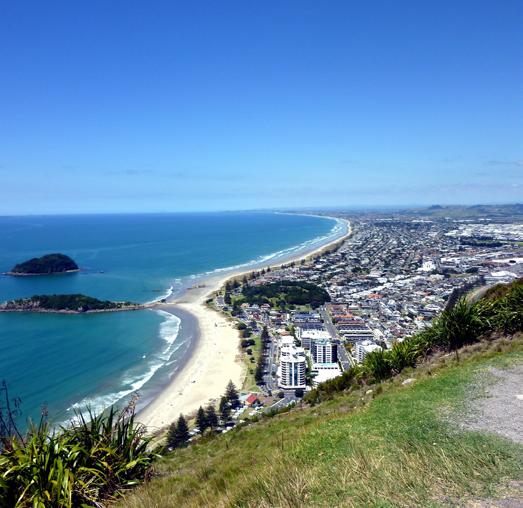
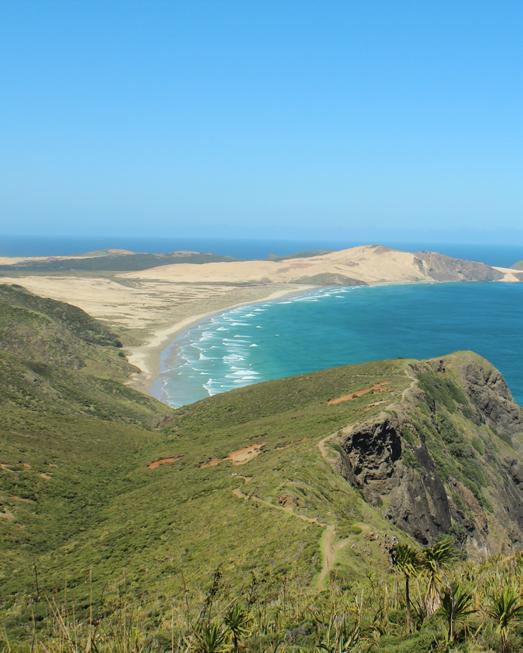
Tauranga’s rate of home value decline hit a speed bump in December.
Home values increased by an average of 1.1% in the last month of last year, following eight consecutive months of negative home value growth. The city’s three-month rolling average also finished the year just about even, showing only a 0.2% decline since the start of October.
At present, many investors are finding the returns on their rental investments have been seriously eroded by big increases in interest rates, particularly as many fixed loans come up for renewal.”
Auckland home values fell further last year than they did in the wake of the Global Financial Crisis.
From 1 January to 31 December 2022, the average home value in the Auckland region went down by 12.3%, compared to a 10.4% average reduction from 1 January to 31 December 2008 – also the last time the region experienced a double-digit calendar year decline.
Papakura (-13.1%), Waitakere (-13%), Auckland City (-12.3%), and Manukau (-11.7%) all averaged double-digit declines last year. Rodney (-8%) and Franklin (-9.3%) were the most resilient of the Super City’s former territorial authorities.
Local QV valuer Hugh
The Northland region’s housing market proved relatively robust in 2022.
From 1 January until 31 December 2022, the average home value fell 2.2% to $734,459 in the Far North District, dropped 4.5% to $790,781 in Whangarei, and declined 3.1% to $878,430 in Kaipara.
That’s in contrast to the national average home value, which declined 10.3% last year to $944,767.
But Tauranga still finished 2022 with home values down 8.3% on average from 1 January until 31 December 2022 – marginally better than after the Global Financial Crisis in 2008, when values dropped by an average of 9.8% over the same period.
QV property consultant Derek Turnwald commented: “Open home attendance has improved in recent months, which is always typical in summer, when properties look better and the weather is more conducive to looking over properties. First home buyers continue to show strong interest in a market that’s receiving very little interest from investors.
“Many investors will be waiting to see if a National government will be voted in this year, as they have promised to reinstate interest as a deductible expense for investment property owners and also re-examine the bright line eligibility and time frames.

The 2022 calendar year could not have been much more different to the one before.
Hamilton home values dropped by an average of 11% in 2022 – a stark contrast to the rapid 29.1% growth the city experienced the year before. As of 1 January 2023, the average home here is now valued at $819,944, which is over $100,000 less than at the same time last year.
Across the wider Waikato region, the largest home value declines on average last year were in Otorohanga (-11.2%), Waikato District (-7.2%), Waipa (-7.4%), and Taupo (-6.6%). ThamesCoromandel District saw the smallest average decline at just 1.9% in 2022.
The latest figures show Hamilton’s rate of home value decline decreased from November to December. “Despite a small month-on-month increase in median house price, I don’t believe this to be the end of the slowing market,” said local QV registered valuer Tom Schicker.
“With inflation not yet at a sustainable level, the Reserve Bank of New Zealand appears set to increase the Official Cash Rate further in an attempt to tame inflation. With interest rates therefore forecasted to increase further throughout 2023, it is likely that the downward pressure on residential property values will remain during 2023.”
“However, there are fewer properties listed at the lower, more affordable end of the property ladder while owner-occupiers appear to be hunkering down in the wake of rising interest rates and the increasing cost of living.”
Looking to the year ahead, Mr Turnwald said interest rates would continue to rise if Reserve Bank predictions proved correct, with further declines in home values likely to follow. “Local agents already report that listings have increased a little and that prospective buyers may be sensing that the market correction is maybe nearing an end.
2.5% to $729,101 in New Plymouth, dropped 7.9% to $441,784 in South Taranaki, and actually climbed 3.8% to $513,299 in Stratford. In comparison, the average value dropped 10.3% nationally to $944,767.
In the December quarter, values fell across the region by an average of 1.4% –a sharper decline than the 0.4% quarterly drop recorded for November.
Last year could not have been much more different than the one before for the property market in Hawke’s Bay.
clarity about the future,” Mr Hall added.
Home values continue to decline in Rotorua at an average rate of 3.4% for the quarter.

As of 1 January 2023, the average Rotorua home is now valued at $670,975, which represents a 10.2% average decline over the last year. It’s a stark contrast to the 22.4% growth experienced the year before, and the 13.7% average growth the year before that.
Local QV property consultant Derek Turnwald commented: “First home buyers are showing renewed interest in the local market despite increasing interest rates and difficulties obtaining finance. A very tight labour market with high confidence of job stability and falling house prices have given them renewed confidence. They also have little competition from investors at present.
“Generally, there is a sentiment that 2023 may be a little more positive than the last few years. The local Rotorua economy is responding positively to increasing tourism numbers, which will be a welcome relief to a region which has been hit harder than most over the last few years. It’s good to see the CBD has more vibrancy again.”
Home values fell throughout the wider region by an average of 12.5% over the 12 months of 2022, compared to an average increase of 34.4% over the 12 months of 2021.
In Napier and Hastings, values fell by an average of 11.6% and 13.4% respectively in 2022, compared to gains of 33.7% and 35.4% in 2021. The latest figures show declines of 1.6% and 2.2% this quarter – a slight improvement on the 3.9% decline both cities experienced in the November quarter.
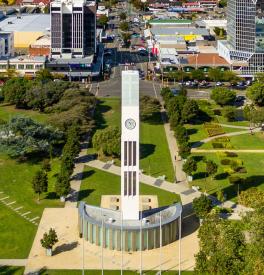
The residential property downturn continues to deepen in Palmerston North.
Home values plummeted by an average of 15.7% last year in Palmerston North – but they still have some way to go before they reach pre-pandemic levels. The average home in Palmerston North increased in value by 20.4% and 28.2% in 2020 and 2021 respectively.

Home values have so far proven to be far more robust in Taranaki than in most of Aotearoa.
From 1 January to 31 December last year, the average home value fell
Local QV registered valuer Damien Hall commented: “The rise in interest rates and the Reserve Bank’s OCR hikes saw the market decline quite rapidly initially. The latest stats show house prices still declining but at a slightly lower rate. The residential property market remains fairly subdued overall, with a low level of activity in what is now a buyers’ market.”
“With further OCR hikes looking likely, and a general election looming later this year, history suggests that many prospective buyers will adopt a wait-and-see approach until there is more
The latest QV House Price Index shows home values slipped another 3.3% during the December quarter to reach a new average of $648,414. That figure is a slight improvement on the 4.4% average decline reported for the November quarter.
Local QV registered valuer Olivia Betts commented: “Palmerston North’s average home value has now fallen below $650,000, following nearly a year of negative home value growth across the city. Interest rates are the main reason for this. They’ve mainly increased throughout the year, adding pressure to affordability. We’re still seeing this decline today in property prices right across the market, in all price brackets.”
Home values fell further in Wellington last year than in any other New Zealand city.
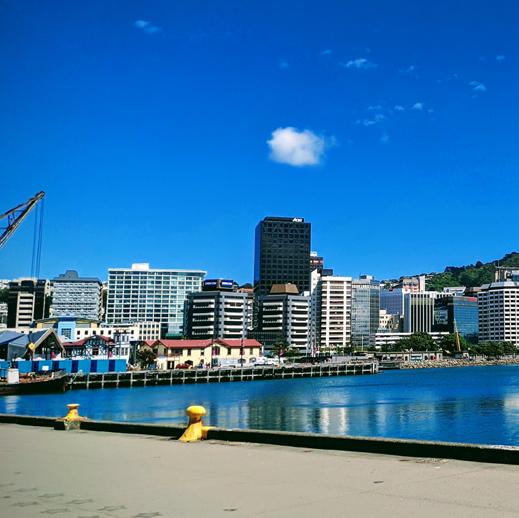
From 1 January to 31 December 2022, the average home value dropped 18.6% to $884,567 – a steeper drop than the national average (-10.3%), Auckland (-12.3%), Hamilton (-11%), Tauranga (-8.3%), Dunedin (-11.3%) and especially Christchurch (-4.1%).
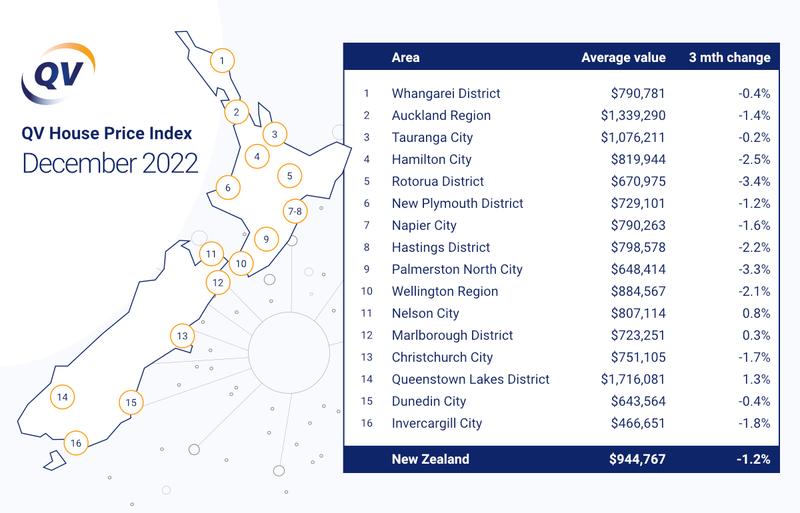
Yet the residential property market still has some way to go before home values are back to pre-pandemic levels. Values also climbed by an average of 19% and 25.5% in 2020 and 2021 respectively.
Local QV senior
consultant David Cornford commented: “Values continued to fall across the Wellington region during the late part of 2022, but the rate of decline is slowing, which could be a possible indication that we’re getting closer to the bottom of the market now.

“The market is likely to remain subdued in 2023 and further value declines are expected, particularly as interest rates continue to rise and put further pressure on mortgaged home owners. Buyers continue to have plenty of choice and bargaining power in the market.”
calmer, more ‘normal’ year for Nelson’s residential property market following three years of volatility?
From 1 January to 31 December 2022, the average home value in Nelson fell 8.9% to $807,114. Almost the opposite occurred two years prior, in 2020, when values increased by an average of 9.8% during the first year of the COVID-19 pandemic. Then they climbed again in 2021 by an average of 23.8%.
QV Nelson/Marlborough manager Craig Russell: “Market confidence was impacted locally by a number of different factors last year, including increasing mortgage rates, and the August weather event. Looking forward, it’s likely that market confidence will continue to be low with further OCR hikes tipped for February, as well as predictions of a looming recession. But we should see a return to a more ‘traditional’ market in the year ahead, relative to all the volatility we’ve seen
since the pandemic.”
“It’s likely that we’ll see a reduction in the supply of sections being created locally, as developers look to land bank while there is less demand and costs continue to increase,” he added.
The West Coast was the only region in New Zealand where home values ended last year in the black.
From 1 January to 31 December 2022, values increased by an average of 7% in Grey District ($390,670) and 6.8% in Westland ($417,008), with Buller District ($329,027) recording a much smaller increase of 0.8%. All

finished the year well above the national average, which was a 10.3% decline.
Otago and Canterbury were the next best performing regions in 2022, with average home value reductions of 1.9% and 2.2% respectively.
in due course the market will find a new equilibrium. We would expect more of the same in the coming months due to current economic factors, which may or may not stabilise until the mid-to-later part of 2023.”
In Christchurch, the average home value declined by 4.1% last year, which again is considerably less than most other cities. Values fell in Auckland and Wellington by 12.3% and 18.6% respectively in 2022.

Canterbury’s housing market performed better than most last year, with values falling 8.1% less than the national average.
From 1 January to 31 December 2022, values declined across the wider region by an average of 2.2%, placing it third nationally in terms of home value growth, behind Otago (-1.9%) and the West Coast, which was the only region to record an average increase in 2022.
Local QV registered valuer Olivia Brownie said it was worth noting that decline over the last 12 months followed average home value increases of 10.1% and 38.3% in 2020 and 2021 respectively.
“Perhaps we’ve yet to see the full extent of rising interest rates, and increasing household costs on the Canterbury property market,” she said.
“It’s likely certain areas of the property market will continue to see further declines over the coming months. There will be uncertainty until interest rates reach their peak and
Dunedin’s residential property market had a relatively quiet start to the summer with the average home value slipping 0.4% in the December quarter to $643,564.
Local QV registered valuer Rebecca Johnston commented: “Traditional market activity through spring and into summer has been subdued and sale prices continue to soften as buyers remain hesitant. This softening appears more so for properties requiring maintenance and upgrades, which are also viewed less favourably by lenders.”
She predicted further home value declines in the year ahead – albeit not at the same rate as the year just been, with values falling across the city by an average of 11.3% from 1 January to 31 December
2022.
“The Official Cash Rate is expected to increase further, with interest rates rising along with it and potentially peaking at around 8-9%. This indicates that there may still be some adjustments to house values, though this should not be significant based on the last year of house price decline.”
“Looking further ahead to the later part of 2023, we may even see the tide start to turn for investors, who took a significant step back from the market last year, if a new government is elected later this year,” she added.

this quarter, alongside Marlborough and Nelson.
Residential property values in Queenstown finished last year 5.9% higher on average.
From 1 January to 31 December 2022, the average house value in Queenstown increased from $1,621,082 to $1,716,081. It marks three consecutive years of growth, with the average home value also increasing by 3.1% and 27.2% in 2020 and 2021 respectively. It experienced no growth in 2019.
Home values increased by an average of 1.3% during the December quarter, making Queenstown one of just three main centres to record positive growth

Home values continue to fall in Invercargill, but they still remain well above prepandemic levels.
The average home in New Zealand’s southernmost city increased in value by 9.9% in 2020 to $397,155. One year later, it climbed 22.6% to $486,715 during the property boom of 2021. As of 1 January 2023, that figure is now $466,651, representing a 4.1% average decline in 2022.

The latest QV House Price Index shows it has been a relatively slow start to summer, with values down 1.8% on average since October.
With December’s housing figures now finalised, Kaikoura now officially heads the list of provincial centres with the most average home value growth last year at 8%. It’s followed by Grey District (7%) and Westland (6.8%), making it an all South Island top three.
At the other end of the spectrum, Rangitikei and Carterton recorded the most negative home value growth at 20.2% and 19.3% respectively.
As a result of Government policy changes in 2021, landlords are no longer being able to claim their full interest costs as an expense. Once, 100% of interest could be claimed by residential landlords, but that is now being incrementally phased out. Currently at 75%, that moves to 50% on 1 April, to 25% on 1 April 2024, and then to zero on 1 April 2025.
“The loss of tax deductibility on interest costs is having a negative impact on the rental market,” Owner of Century 21 New Zealand Tim Kearins says.


“Alarmingly, that’s only going to get worse as interest rates increase and the policy rolls out to completion.
“Banning interest deductibility really seems to be both hurting and deterring ‘mum and dad’ landlords. Many of these people once viewed a rental property as a good investment. Now many of our ‘mum and dad’ investors are now either getting out of the residential rental market, or not considering it in the first place,” says Kearins.
The ongoing costs on landlords is seeing them direct their money and focus towards the likes of commercial property syndications, the share market, or even bank term deposits given the rising returns.
“Not only do extra costs see Kiwi landlords fleeing the residential rental market, but it’s flowing through to rents, with overall rents reportedly up $150 in the past five years, only adding to our country’s cost-of-living crisis,” says Kearins.
For a lucky few who might be able to get a deposit together to buy a house and secure finance, now is the time for renters to do their sums on lending affordability with some great
on by the Government, a survey commissioned by the Ministry of Housing and Urban Development finds
opportunities out there for first-home buyers.
“With rents still sky-high, but with house prices softening, flatmates will be looking at each other and wondering if they can cobble a deposit together and service a mortgage. Likewise, couples and single
people will be considering a boarder to help secure them a mortgage.
“While it’s not a good time to rent, it’s quite a good time to buy.”
Tim Kearins Century 21 New Zealand OwnerA quarter of landlords put up rents in the six months before May 2022, and one of the big reasons for this was increased costs lumped

Elections rarely disrupt market activity from its existing trends, research has found, but Colliers says this one could be an exception
Research undertaken by Colliers on residential and commercial property market sales activity immediately prior and post the past seven elections in New Zealand highlights that elections rarely disrupt market activity from its existing trends, unless there are significant government property-related policies in the limelight.
Given the current differing policies and views between the major parties, and the recent resignation of the
Prime Minister creating policy uncertainty, there is potential that the 2023 General Election in October will have a rare influence on property market sales activity, but mostly for the residential sector.
In six of the seven election campaigns since 2000, there has been little influence on sales activity. However, the one exception was the 2014 election campaign. In 2014, Labour promoted a capital gains
tax (CGT) and restrictions on the ability of overseas entities to purchase residential property. These policies contrasted with National’s, which were viewed as supporting the status quo. This divergence saw a slowing of sales prior to the election date and a surge following it when the emergence of a National-led government removed the uncertainty in outcomes.
Market dynamics during other campaigns post-2000
have been influenced more significantly by regulatory, economic, financial, and demographic drivers such as changes to economic activity, lockdowns, LVRs, interest rates, access to finance, migration, and the availability of housing.
When assessing the housing related policies of Labour and National currently, there are some similarities, but also divergence, predominantly on social and emergency housing initiatives, and tax-related issues such as
the extension to the brightline test, and the removal of interest deductibility for landlords introduced by the current overnment. The RMA reform process, and infrastructure and funding programmes are also areas of divergence between the two parties influencing residential property markets.
What also impacts residential market activity is uncertainty. The change in Prime Minister nine months out from the election adds

been made for this term of parliament. Therefore, no changes are expected to be made in this area until mid-October. However, no indication was provided on what a future term may hold if Labour were to be re-elected. Inevitably, clarification on CGT will be needed to quell any market concerns. In the interim, investors may choose to hold back until the stance is confirmed, as well as the election result.
commercial property investors seem to indicate there is some influence on the market from elections. Colliers’ commercial and industrial property investor confidence survey results surrounding the 2011 election showed an increase from a net positive 4.4 per cent (optimists minus pessimists) in the December quarter of 2011 to 15.6 per cent in the March quarter of 2012. Following the 2014 election, the September quarter figure
importance of economic and financial stability and low interest rates. By way of example, the jump in 2021 sentiment and sales activity was a result of the record low OCR rate of 25 basis points and other quantitative easing measures in play at the time rather than the election. By March 2022 when interest rates were being hiked, investor sentiment declined to a net positive 5.4 per cent.
Therefore, rather than any
some uncertainty into the mix of policies that could impact the sector. More announcements on policies will be released under the new Prime Minister Chris Hipkins in the coming months providing more clarity.
However, current indications highlight some tweaks to the status quo.
An ongoing area of contention is CGT, but new Prime Minister Chris Hipkins clarified that he would be honouring the commitments that have
and industrial property sales activity and elections since 2000 shows little divergence in purchasing trends when analysed against election campaign periods. This is potentially a result of the sector being less influenced by policy outcomes than the residential sector. However, there is an exception, which occurred following the 2020 election.
When analysing sentiment rather than activity,
of a net positive 25.1 per cent increased to a net positive 30.6 per cent in the December quarter. In 2020, the election quarter result was 7.4 per cent, which increased to 22.9 per cent and 37.7 per cent in the two following quarters.
This indicates that commercial and industrial investor sentiment is affected slightly before elections more so than activity, but investors are quick to resume their preelection activity levels soon after. It also highlights the
current election policies influencing commercial and industrial sector sales activity in the second half of 2023 and the first half of 2024, it will likely be short-term economic and financial disruption caused by high inflation, increasing interest rates, and a Reserve Bank currently preferring to engineer a recession for 2023 rather than a soft landing.

The team was forged by three friends working in the industry who realised that the key thing stressed building managers, business owners and landlords needed was to make a single call and get a reliable and qualified support team that would cover any aspect of facilities management.
The Rapid trio set down a business philosophy that “we will do what others can’t or won’t do “ and set about assembling a highly trained, efficient and safety-conscious team of professionals who get the job done right, the first time.

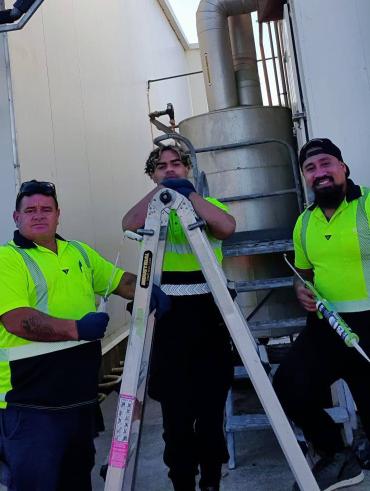
Today that service stretches from food manufacturers’ audit cleaning, all aspects of industrial cleaning, painting, building and floor safety management to anti-microbial and moss
Having worked in the industry for many years, three friends, Paul Schoch, Robyn Schoch and Andrew Chan realised that by combining their skills, they could create a company unlike any other
ceilings, walls, floors and specialised equipment.

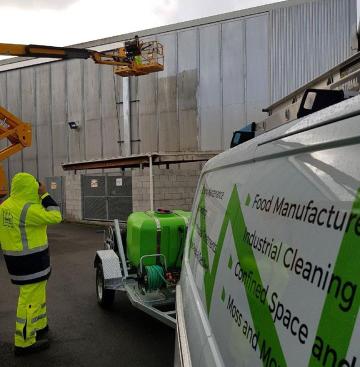
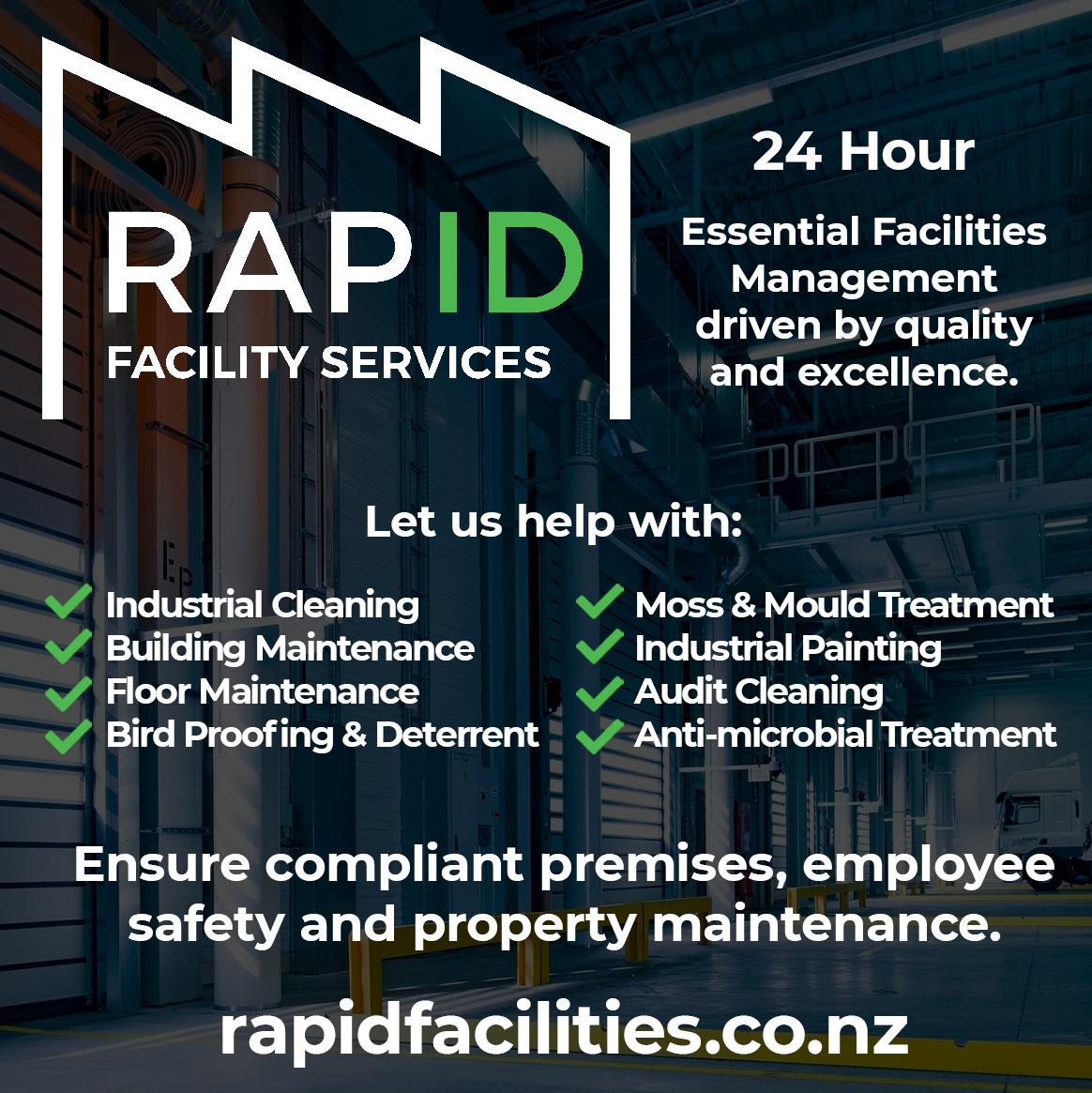

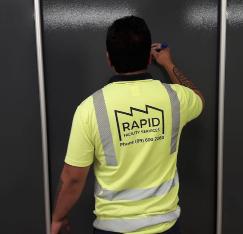
Given 40% deposits (unless buying a newbuild), low gross rental yields, higher mortgage rates (not to mention tough serviceability tests), increased compliance costs, removal of interest deductibility, and flattening rents, there are several key challenges for a would-be new investor.

With these challenges, it’s little wonder the CoreLogic Buyer Classification data shows that mortgaged multiple property owners (MPOs, including investors)

Economist Kelvin Davidson shares his thoughts on the likelihood of property investors jumping back in
are currently running at about a 21% share of purchases, close to all-time lows.
That being said, the situation is not a total disaster. Those figures still mean that one in every five deals is going to a mortgaged MPO. Kept in context, it’s within a low overall number of transactions. But clearly some investors are still finding value and new-
builds are no doubt one of these opportunities. Anecdotally there are relative ‘bargains’ to be picked up, with some developers looking to shift stock so they can crack on with their next project. In the weak market, others will simply be doing deals on existing properties at discounted prices.
Meanwhile, cash MPOs, yes they do survive in any economic storm, are
enjoying the weak market conditions too. Their share of purchases has risen to a record high from around 10% in late 2021 to closer to 15% now. In a market where finance is restricted and costly, it stands to reason that ‘cash is king.
When we look at investor activity by size of portfolio, the drop in market share has tended to be a bit bigger for those with fewer properties – in other words,
the ‘Mums and Dads’ have found the going a bit tougher than bigger landlords. Again, that makes sense in the current market conditions, given having the resources or banking relationships for a deposit to keep buying is challenging.


If we put ourselves in the shoes of an investor, what would be worth considering over the coming months and is it a time to buy? The first question, for investors and buyers more broadly, is to ask when property values might bottom out? No one knows exactly, but my working assumption is that as mortgage rates finally peak in the next few months (if they haven’t already), we may see sales activity pick up a little in the second half of the year and property values in many parts of the country find a floor.
Other considerations include whether the New Zealand National Party (National) wins the October election and reinstate interest deductibility? This scenario does seem to be getting more likely as the
days go by, but it’s probably still prudent to work the numbers on what we know now, and if the rules change, that’s a bonus for investors.
be on its way in 2024, which would be when the formal caps on debt-toincome ratios are likely to be introduced. The cap could be set at seven for
from other income sources over a three- to five-year horizon versus the scope for renewed capital gains over that period, which are uncertain and only ‘on
How will lending rules evolve will also have an impact although I’m not anticipating any changes to the loan to value ratio rules (LVRs) this year.
November’s Financial Stability Report might signal a loosening could
all borrowers, with a speed limit system and new-build exemption. Learn more about LVRs in this explainer.
Ultimately I suspect many would-be investors are currently weighing up the need to top-up a property investment’s cashflow
paper’ until realised.
It’s by no means an easy balancing act, but one factor that will work in favour of investors are signs that net migration is back in the black – a boost for tenant demand and rents this year.
Buyers who have been active during the Covid-19 era may look to review their portfolios as a volatile interest rate environment causes capital challenges.
Such market activity could present opportunities for those who remained on the sidelines during the price surges of 2021, namely high net worth individuals who have been notably dormant of late.
Well capitalised listed funds that are local or based offshore could also look to take advantage of changing market conditions as there is still considerable equity around.
As market values evolve, there could be an increased demand for asset valuation as owners assess their portfolios in a changing environment.
Ultimately, this may lead to some prime properties being put up for sale and we expect that could take place as early as Q2 of this year, leading to accelerated market activity.
Late last year, inner-city development specialists Precinct Properties partnered with global private investment firm PAG on a $240 million purchase of 40 and 44 Bowen Street in Wellington, which Colliers brokered.
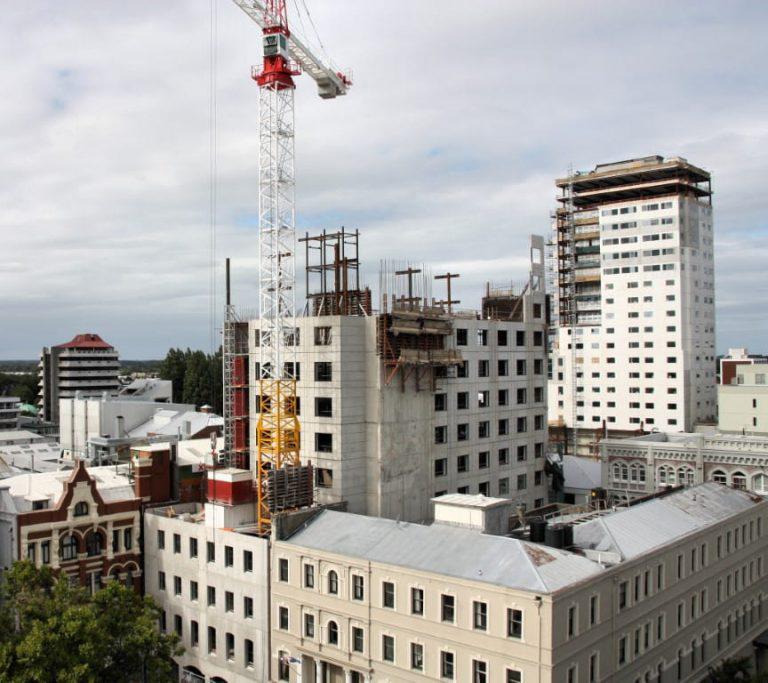
This was a notable deal and could be an indicator of what is to come in 2023 as listed funds look for capital partners.

Development sites that are no longer financially viable to develop and don’t provide holding income also loom as likely purchasing opportunities as owners evaluate their options.
Coming off historic
price highs, buyers and vendors are likely to realign and match their pricing expectations during the next 18 months.
In 2023 we may see the peak of inflation and interest rates, which could further bolster investor confidence.
An emerging trend the
Colliers Investment Sales team saw in 2022 was the prevalence of owneroccupiers acquiring vacant or soon-to-be vacant stock, which provides flexibility for the future rather than being bound to a lease.
The office environment will continue to evolve as more businesses place
Investors looking to recalibrate their assets during the middle stages of the year could spark increased activity in the commercial property market, Colliers New Zealand CEO Mark Synnott believes
an even greater emphasis on providing attractive workspaces for their teams so they can retain and attract staff, while encouraging them to work from the office following extensive periods of working from home.
As we saw with Beca’s commitment to a new premises in Wynyard Quarter, new builds and premium offerings will remain highly desirable. That also creates opportunities for secondary stock to be refurbished to meet tenant demands.
The environmental, social, and governance (ESG) goals of New Zealand companies have largely centred around climate change initiatives, but social aspects will continue to grow in importance through an increased focus on personal wellbeing.

To take it a step further, aside from the standard ESG requirements, future
developments such as buildings, office blocks, and shopping centres will also cater to people with physical impairments, vision or hearing loss, or short-term injuries.
Colliers has recently begun collaborating with Be. Lab, a social enterprise that focuses on innovative and creative social change programmes that support businesses and communities to become fully accessible.
Our team members will be engaging with them more broadly in 2023 to ensure we can provide the best advice possible to promote accessibility in the properties we are connected with.
One of the most exciting projects that will take shape this year is the development of New Zealand’s first premium outlet shopping mall that will enjoy significant profile as part
of the expanding Auckland Airport precinct.
The project has received substantial leasing interest and will be a sought-after shopping location for domestic and international visitors when it opens in 2024.
The demand for workers remains an ongoing challenge for Kiwi businesses in a tight labour market and there’s a range of sectors that would benefit from further loosening of immigration settings.
One of those sectors is the hospitality industry and while a recent increase in international visitor numbers coupled with strong room rates will likely see hotel revenue per available room jump to preCovid levels by the end of the year, labour shortages and increased operating costs will continue to place pressure on some businesses.
Strategic investors will be attracted to highquality assets looking
for sustainable revenue growth as the wider tourism industry continues its recovery cycle.
Across the rural sector, interest in land which offers synergies between arable, pastoral, dairy, and forestry farming classes will continue to elicit strong demand.
The prospect of a sustained period of high dairy prices following a potential record payout in the 2022/23 season will bolster demand for dairy farm assets despite the impact of rising interest rates.
In the residential space, rising interest rates and increasing living costs will impact the housing market and pricing may not level out until 2024 as construction prices stabilise.
It will be hard to see where values will lie during the next year having come through such a period of price spikes and the low interest rate environment.
How has the Certification industry been disrupted by the Covid environment and what have we done to combat the changes


Ayear ago I wrote an article on this very same topic. At that time New Zealanders, and in particular those of us up in the Northern part of the North Island, had just come out of an extended period of restrictions.
Little did we know that we would return from the Xmas break and be pushed back into another series of restrictions.

As the year unfolded New Zealand finally threw open the doors and allowed both its people and international visitors to start the process of travelling freely up and down country again.
By the time this all came into being we had all spent more than 2 years managing Covid through an initial eliminate strategy, and ultimately a learning to live with the virus world
In the previous article I focussed on the core operational levers that we had been required to review and amend to allow our business to operate and effectively survive.
Now a year later all of the changes we had determined to make are either locked in or in the throes of being locked in.
There is one area that continues to be a significant struggle for all businesses throughout New Zealand, and we at Telarc are not isolated from it. This area is the way in which we attract, retain and support people in a post Covid world.


We are a normal business by New Zealand standards. We employ just under 50 people. We have workers



based from Auckland in the north down to Dunedin in the south. We have clients on Stewart Island all the way to Kaitaia in the north.
Five years ago the business employed predominantly European males with an average age of late 50’s to mid-60’s.
Covid’s arrival saw a number of those employees retire. When seeking to replace the retiring wave we had in front of us we found ourselves increasingly looking at and employing really good candidates from offshore.
So when you look at our business today it is a completely different demographic.
Half of the current team identify as NZ European. We now find ourselves with the balance of the team being born and educated in
places such as Iran, Pakistan, South Africa, Zimbabwe, India, Korea, UAE, Croatia, Germany, Canada, Fiji, the UK and Australia.
Encouragingly as we have on-boarded these people the male/female split is now lifted to 60/40. And our remuneration is based on role and competence within the role as well as performance.
Where have the workers gone? The change is not something we had planned for. What we discovered as we looked to replace our ageing workforce was that there weren’t many New Zealanders with the experience and qualifications we needed who were looking for work.
You may ask why? The challenge we have is that we need people with real world experience. We audit predominantly infrastructure management, manufacturing and construction companies. The building of those entities took place, in a good proportion of cases, many years ago.
As we, in New Zealand, have automated processes and downsized traditional operational training grounds for new talent coming into the industries sectors mentioned earlier we have seen the pool of “could be” auditors diminish.
On the other hand, in the countries I mentioned earlier, from whom we are sourcing qualified people, we are able to access people who have been involved in, or supported, the development and management of large-scale infrastructure projects. This is both in their own countries as well as within the regions they
have resided in / travelled to.
By having the experience they do, and also having been exposed to management system auditing, they arrive really well qualified to support the growing certification market that New Zealand is experiencing.
We still find the odd diamond in New Zealand who brings the work experience we need to the job. In most cases, though, the people who do successfully come to us do have a number of years of experience in a variety of operational roles. This leads to our having to jointly invest between 9 and 12 months to be trained, and supported, to be confident when they start their stand-alone auditing journey. We continue to support and on-board local people, but as I have said the journey to being confident is a long one.
The other aspect to weigh into this equation relates to “where have all the New Zealand workers gone”. We hear all sorts of reasons including – early retirement, overseas experience (delayed or just the right time for it), moved to another country for higher pay or lifestyle, became a real estate agent or property developer pre-2022.
The list of reasons is getting longer and, to be honest, it is not something we can influence change in overnight. It is what it is and as a result we solve for today’s problems with the most suitable resource we can find. And on the whole the best qualified come to us from offshore.

With the on-boarding of people from all over the
globe we have found ourselves facing dilemma’s that we wouldn’t have predicted in a pre-Covid world.
A good example of one of the challenges we face is dealing with spoken and written English. For a number of the people who have joined us English is the second, or third and even sometimes fourth language of choice for them.
So things that would normally be taken for granted, such as writing or defining orally a concisely worded observations or recommendation, can initially be a struggle for some of the new people we have employed.
Add into this the idiosyncrasies that make New Zealand business, and social banter, challenging for new arrivals results in both our clients and our new auditors ending up being a little frustrated in finding com-

mon understanding.
We recently ran a structured approach towards better understanding some of the dilemma’s auditor’s face when getting out into their first “stand alone” engagements.
One of the biggest insights related to keeping the onsite auditing engagement calm. When managing an audit the last thing the auditor wants is for the audit to turn into a “voices raised” and “defensive” engagement. Finding ways to put all parties at ease is a skill. And when achieved allows the engagement to proceed with minimal flare ups or disruptions.
Even for New Zealand born and raised auditors, out on their first “stand alone” audits, keeping the engagement calm is challenging.
They come to the engagement understanding
Telarc is a Jas-anz Accredited Certification Body which provides qualified, competent, New Zealand auditors, who are industry coded to provide relevant and impartial intervention for a large range of New Zealand business regardless of the business size.

The body is able to provide New Zealand business with an individual or a team of auditors capable of assessing one or multiple standards across one or multiple sites.
While the key priority of any commercial relationship is to deliver a product or a service, there is an increasing need from businesses to have confidence that their tendering parties and suppliers are managing their business in a manner that won’t negatively impact the supply relationship.
There are increasing demands from buyers for their suppliers to provide confidence that they are operating their business in a manner that is delivering good quality and environmentally
aware products (ISO 9001 and ISO 14001) while managing workers in a way that protects worker well-being and safety (ISO 45001).
There is more demand across other areas such as ethical work practices, Asset Management (ISO 55001) and IT Management (ISO 27001).
Accredited Certification looks for gaps, risks and improvements in the way that work is actually done versus the way it is planned and communicated.
This provides visibility of where work practice and or documentation anomalies lie in all levels of the business. This then leads to improvement activity so Certification can be granted.

The second growing area that is driving minimisation of risk through Certification is through board and senior leader directives.

Over the last decade, legislation and regulations have looked to push culpability for sub-optimal work practices towards senior leaders and boards.
the idiosyncrasies of New Zealand and its language. So when a recent arrival to New Zealand who is operating with English as a 2nd or 3rd language is trying to i.) Interpret the spoken word while, ii.) trying to keep the client calm and engaged, the world can turn messy very quickly.
I haven’t even touched on the writing of reports in this overview as this then creates the next downstream challenge for the new arrivals.
For those of you reading the article you probably are thinking why bother, if it is going to create all the frustrations alluded to above?
What we have found is the people we are hiring from off shore are intelligent, motivated, qualified, “keen as” workers who want to live in a country where they can safely raise their family while working hard.
When I was growing up, the qualities I see in the people moving here is what differentiated New Zealand from other countries and made our people successful all over the world.
To that end increasingly we are going to become more reliant on workers coming from countries around the globe. Understanding their culture and their difficulties when integrating into the New Zealand way is going to be a challenge we will have to solve for.
The above is one example of the challenges we are facing in a post-Covid world. There are a number of others, but for this exercise I think it is better to focus on one area to highlight the changes we will all have to deal with over the
Once an organisation accepts that the days of being the “good old kiwi business” are gone and that the new world order requires a very open, culturally diverse mind-set the overarching people management ethos changes, significantly.

The key is to embrace the change and find ways to adjust our mind-set to remain successful, rather than fighting it.
Which is a nice segue into the final point of this overview.
The greatest challenge post Covid is mind-set. Trying to bring back the past, trying to replicate what we want and trying to carry out work in a way that was successful before is not going to be easy.
Mind-sets need to change and need to adjust to a new world order in which the globe is becoming a huge resourcing opportunity, and that we should get the best people we can before someone else does.
Risk comes in many forms and certification helps over a variety of levelsPhilip Cryer is CEO of Telarc, a Crown Entity subsidiary with a vision to provide its clients with end to end, impartially audited
SLABX200 is EXPOL’s new generation high performance Expanded Polystyrene Board specifically designed to deliver high compressive strength and improve insulation under concrete slabs.

It delivers an uncompromised compressive strength of 200kPa @ 10% deformation and exceptional Insulation Values. Specifically engineered for residential and commercial projects, its high performance gives engineers and specifiers peace of mind while increasing the thermal performance of a building.
SLABX200’s durable nature means it will not degrade over time, keeping its integrity for the life of the structure.
SLABX200 delivers the ultimate high performance:

Uncompromised compressive strength 200kPa @ 10% deformation
Exceptional Insulation Values
High water resistance
Lightweight and easy to handle
Various thicknesses from 50mm to 600mm
SLABX200 waste is actively recycled into other EXPOL products
SLABX200 - the product of choice for specifiers and the construction industry.

Learn more about SLABX200 visit www.expol.co.nz Call or email our Technical Manager; T: 0800 86 33 73 or E: tech@expol.co.nz
3.0 R-VALUE @100 mm
200 k P a STRENGTH @ 10% DEFORMATION
No matter where your business travel takes you, you can live as local as you like. Want to find an award-winning flat white? How about the best restaurant to charm clients in town? Because we’re local, we can point you towards the very best.
QUESTAPARTMENTS.CO.NZ



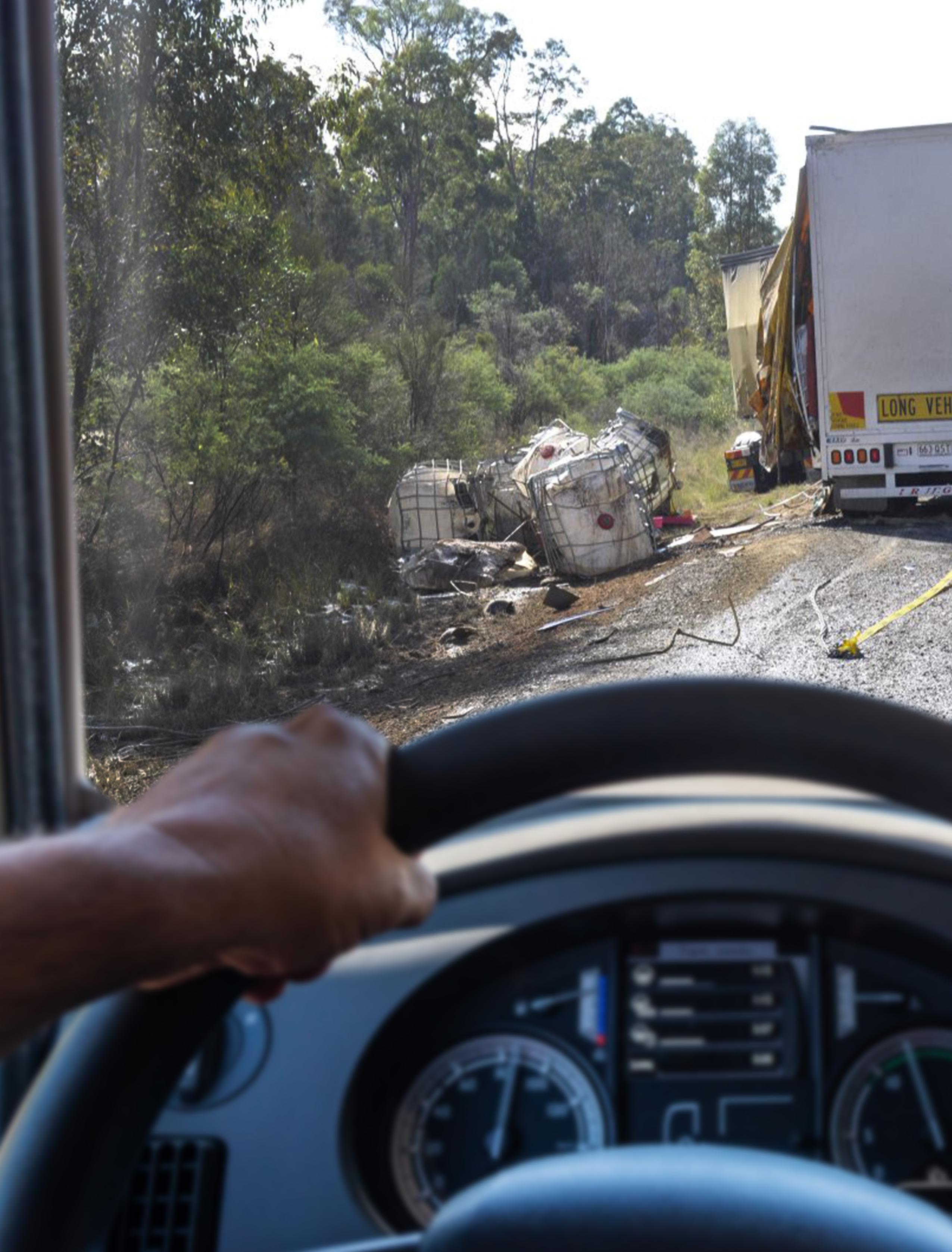
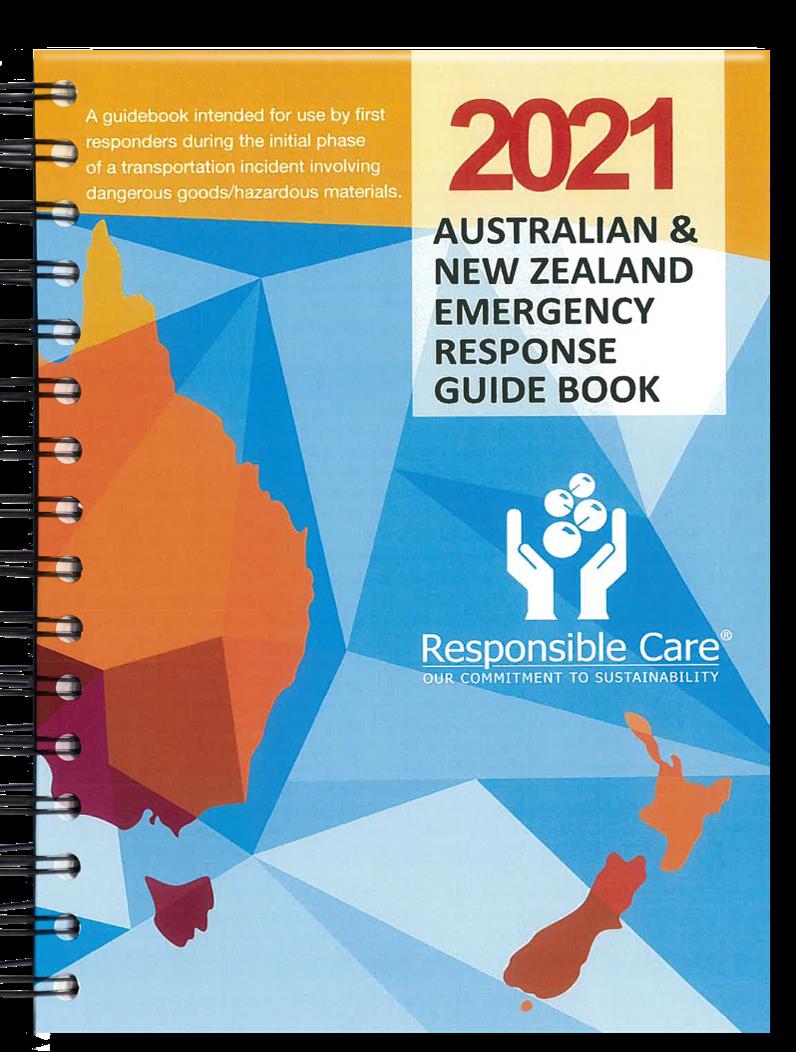
Changes to our Global Harmonisation System (GHS) chemical regime applying from 30 April 2021 require accurate and timely advice - non-compliance could prove costly.
Competent staff avoid expensive and sometimes confusing compliance advice, while enabling an effective response to chemical incidents, often without requiring emergency services.
Inspectors and certifiers with years of expertise warn of a declining national workplace chemical safety performance.
A crucial factor is the continuing loss of onsite chemical safety advice, primarily due to replacing flawed but effective mandatory Approved Handlers with whatever employers now deem sufficient.
A second major chemical incident in the same public facility is a timely reminder that safe chemical management is not receiving the attention it deserves. Competent staff are essential.
NZ (RCNZ) Competent Chemical Handler Certification courses are tailored to reflect your chemical inventory and enable compliance.
Upskill the last of your HSNO Approved Handlers, update Certified
Handler requirements and successfully implement the updated Global Harmonisation System (GHS).
For struggling, noncompliant business operators who are attracting attention from enforcement agencies, practical onsite advice from Competent Chemical Handlers helps lessen the load on a diminishing number of Compliance Certifiers. It helps to ensure site chemical safety measures remain effective.
RCNZ Competent Chemical Handlers (CCH) are increasingly in demand, resulting from our popular ‘Walk and Talk’ site visit to assess actual chemical management performance, identifying the need for specialist training, throughout the product life cycle.
Chemical incidents now guarantee media attention, often sensationalising the incident by highlighting persons adversely affected by unwanted exposure to chemicals.
This can irretrievably damage reputations to both customers and suppliers, particularly if employers have not taken all practicable steps to safely manage their chemical inventory throughout their operations.
When chemicals do cause problems, employees, customers, WorkSafe
Ensuring staff are competent to safely manage the harmful chemicals essential to your business includes your effective response to a chemical incident.
To enable a smooth, cost-effective transition to and beyond compliance, you need compliance tools:
- the updated RCNZ industry Codes of Practice reflecting our revised GHS chemical management system
- your 24/7 CHEMCALL® emergency response subscription; and the all-important ‘how to’ advice arising from our popular site ‘walk and talk’ assessments - replacing your Approved Handler with our Competent Chemical Handler certification
These are all cost-effective measures which add value to your business.
Talk to us today about compliance tools, which confirm you are a good employer, committed to safeguarding employees and our environment by safely managing your chemical inventory.
Responsible Care NZ 04 499 4311
www.responsiblecarenz.com
inspectors, local authorities, health protection officers and emergency response organisations all benefit from the expertise and product safety information available 24/7 from 0800 CHEMCALL®, our industry’s unique, subscription based chemical emergency advisory service.
Supported by thousands of compliant Safety Data
Sheets (SDS) combined with their collective industry expertise and local knowledge, CHEMCALL® responders provide callers with comprehensive advice about how to safely manage the incident, safeguarding people and often avoiding business disruption.
A nine-month old report by the McKinsey Health Institute is even more relevant today as we tenuously cling to the hope we may be returning to normal and have plenty to live for
Over the past century, life expectancy has dramatically increased in most parts of the world. But the portion of life we human beings spend in moderate and poor health hasn’t changed, says the report.
This means we spend more years in poor health than at any point in history.
Moreover, significant inequity continues to exist across and within countries.
Humanity mobilized against COVID-19 at a speed and scale previously unseen. While far from perfect, our success should inspire us to challenge what we think is possible, according to the report.
“At its best, our response to COVID-19 demonstrates that when resources and motivation coalesce, scientific breakthroughs and large-scale behaviour change are possible in very short periods of time.
“It’s time to set a new, more ambitious, more relevant goal for human health—a goal that galvanizes across continents, sectors, and communities to support everyone on the planet in adding years to their lives and life to their years, the report says.

As a starting point for discussion, the McKinsey Health Institute (MHI) believes that over the next
decade humanity could add as many as 45 billion extra years of higher-quality life—roughly six years per person on average, and substantially more in some countries and populations.
The institute says that achieving this objective requires us, as a society, to challenge our beliefs about health and re-orient material portions of public policy and the economy.
It requires viewing health as an investment, not an expense.
It requires embracing a modernised understanding of health, including physical, mental, social, and spiritual health and the full richness of factors that
influence those elements of holistic health.
It requires scaling solutions that work, which could address 40 percent of the disease burden.
It requires dramatically more innovation and leadership from institutions outside of the traditional healthcare industry.
And it requires fully empowering individuals to steward their own health.
The report was prepared by Erica Coe , Martin Dewhurst , Lars Hartenstein, Anna Hextall, and Tom Latkovic
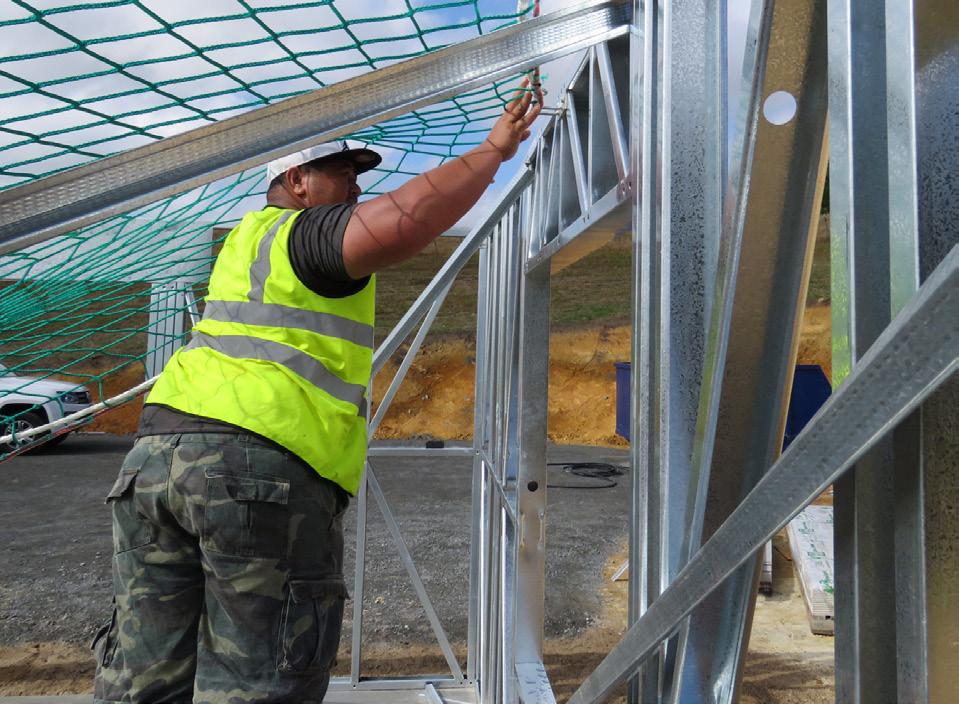
With the enactment of the Health and Safety at Work Act (2015) it became apparent that there was a need to assure customers that they comply the requirements of the Act in safety measures for fall arrest.
“We needed to have our system independently analysed, engineered and ultimately certified. This meant that not only did the individual components of the safety net fall arrest sys-
tem have to be tested, the performance of the safety fall arrest system as a whole also needed to be studied,” says General Manager Craig Daly.
A team at the School of Engineering and Technology at Massey University tested a variety of drop heights and weights, different bracket centres, various net sizes and points where the load strikes the net.

“It even tested nets of different ages and repaired
nets, with the results being collated and analysed to effectively confirm that our safety fall arrest system works,” says Daly.

“This enables PCBU’s to discharge their responsibilities in regard to the requirements of the in the use of a system that is without risk to the health and safety of it’s workforce.”
When the nets have been installed and inspected by a Safety Nets NZ team and a handover certificate
completed by our certified rigger, the client can then commence works above the safe area of the net.

“All of our safety documentation has been produced in such a format as to ensure that it complements the overall site safety policy and manual that the Principal Contractor is required to establish on all projects,” says Daly.
Click here to read inspection guidelines
The National Health & Safety Leaders’ Summit on 27-28 April will allow you to keep in tune with the latest trends and innovation in workplace safety.
While a risk-engaged workforce is critical, leadership commitment comes first if you want to
to analyse the current challenges in achieving safe and healthy workplace cultures.
It will provide crucial updates on all the new regulations, legislation and evolving changes in work environments.
develop a safety climate for engagement at all levels. Ask yourself what lenses does my organisation have for management commitment to health and safety, hazard identification and risk assessments. How do we ensure employee buy-in and participation?
The Summit will guide participants in how
On day one progressive approaches are discussed while the second day offers two coinciding full day streams.
One will focus on improving health and wellbeing at work while the other brings about a format covering innovation and technology implementation for health and safety transformation.
Rebecca Crompton is
a Senior Health & Safety Expert and Director at FEFO Consulting and is an Australian Small Business Champion Awards Finalist. She will share on the latest trends and developments in business health and safety management and will reference the current labour market conditions and

from them cross over.
A Panel Discussion on Delivering Safety Differently and Rethinking Health and Safety Leadership will include panelist presenters from Fletcher Building, Westland Milk Products, Hall’s Cold Chain Logistics, Learning Teams Inc.
The role of directors in the promotion of culture safety is paramount. Safety governance creates the good, the bad and the ugly in operational performance and can include a ‘chronic unease’ that comes with the responsibility.
Brett Murray, Chief Executive of Site Safe New Zealand will talk about the assurance one needs and how you can get it.


The plenary day also has sessions on workforce engagement by a representative from Ports of Auckland and guidance on moving from a compliance culture to a safety culture presented by Air New Zealand.
Streams on Day Two have sessions synced so you choose the topics that matter to you most. Themes include:
• New Technology and Innovation
• Risk Management
• Mental Health and Psychological Safety
• Delivering Wellbeing Programmes.
economic circumstances.
Reviewing ISO standards never goes wrong and Kristin Hoskin, Principal Consultant Safety & Risk from Advisan will talk on International Standardisation.
Different industries have health and safety programmes to suit their sectors; but the learnings
WORKSAFE’s Phil Parkes and Daniel Hummerdal will talk on creating a mentally healthy workplace by defining the principles of good work design and sharing the the outcomes.
Groups are encouraged to attend. Teams can book with special pricing for three or more participants. View all sessions and details at brightstar.co.nz/safety












The covid pandemic provided cyber criminals with a fertile ground to execute scams and reap the riches. Attacks designed to steal company and customer information rocketed in the last two years.
According to the security companies about a third of cyber-crime victims are small businesses.
CERT NZ, the government agency that tracks cybercrime reporting, says 2069 cybercrimes were reported in the third quarter of last year, continuing to grow from the previous year.
The most common crimes were phishing, credential harvesting, scams and fraud as criminals worked to gain access to company emails.
After a company’s email
accounts are compromised, they are often used for the unauthorised transfer of money, but it’s not just data being accessed, it’s stock exchanges and healthcare under attack internationally, reserve banks, power grids, and hospital operating theatres.
A UK government study has found that 56 percent of small businesses that suffer a breach are victims of further attacks. They also found 66 percent of businesses attacked make no substantial changes to prevent future attacks. New Zealanders are also inherently complacent. It is estimated 80 percent of cybercrime could be prevented by individuals and businesses doing some pretty simple things such as using updated complex
passwords and using a password safe to protect those passwords and make it easy for you to manage them.
Kiwi businesses and organisations must act immediately to block future cyber hacks which is costing New Zealand vast sums every year. The covid pandemic has increased New Zealand’s reliance on digital devices and the internet.

NZTech, which is organising a New Zealand cybersecurity summit in March with Brightstar, says that it is time for the government to put funding into educating New Zealanders about how to avoid being a victim of cybercrime, just as government does for road safety.
About 87 percent of Kiwis concede security of their personal information online
is important but 40 percent say safeguarding their information is inconvenient.
The March cyber summit delegates will hear from experts and peers at the coal face of cyber security about the realities of cyber in the modern business environment.
Cybersecurity was a major topic of at the World Economic Forum’s recent meeting in Davos, Switzerland. Experts warned that cyberattacks are increasing in sophistication and frequency. There’s a gathering cyber storm brewing and it’s really hard to anticipate just how bad that will be, Davos delegates heard.
www.makelemonade.nz
This year has been earmarked as one of significant cyber risk to organisations, NZTech chief executive Graeme Muller says
Civil infrastructure company Dempsey Wood monitor levels of emissions from noise, dust and vibration in real time that until recently, required on-site manual testing.
“Working within strict consent limits around emissions has constantly been a challenge and maintaining a positive relationship with nearby residents is crucial,” says Dempsey Wood Innovation Engineer, Wil Killip.
“The use of heavy machinery on worksites within busy residential areas comes with the obvious disturbances of noise, vibration and if the weather is dry, copious amounts of dust.
“We needed to find a smart way to help keep our levels of emissions down and surrounding residents happy so we’ve leaned on Environmental Monitoring specialist company Adroit and Spark IoT, to deploy a range of sensors that will alert us to any impending breaches.
“It is also modular, so we can easily add more sensors to monitor different parameters such as sediment in water run-off or even weather conditions.
Delayed monitoring or inaccurate reporting can lead to potential breaches in compliance, resource consents, health and safety, and complaints from local residents, which can then cause project delays and add costs
“Data from the sensors is then transferred to an easy to read visual dashboard that lines up with the thresholds in our actual project resource consents, providing an easy overview for our staff to know when we might be close to crossing a threshold and alerting us through our phones on email or app so we can act swiftly to avoid any disruption.”
Dempsey Wood are using the new technology at a worksite in Lower Hutt where they are building a new Summerset retirement village.
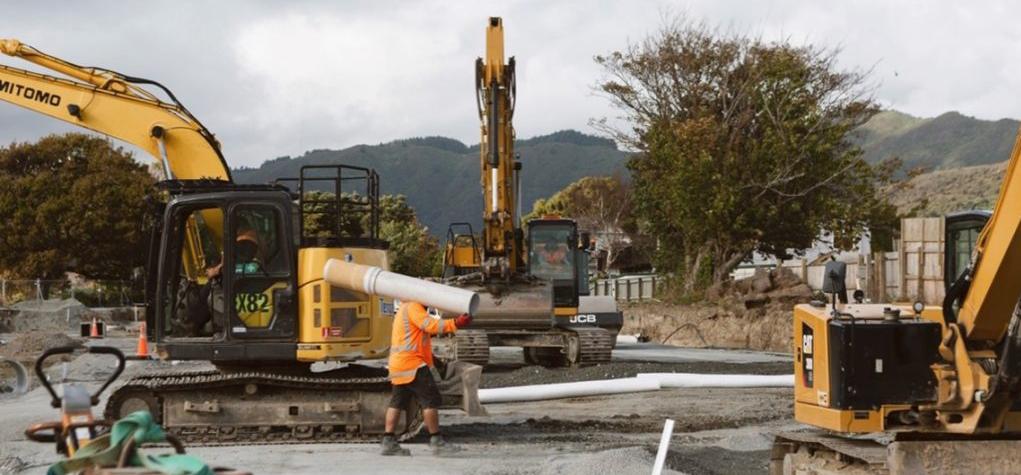
Adroit Founder and Technical director, Ulrich Frerk says that in the past a
contractor would be called out to measure the cause of the complaint and report the result.
“This is both time and cost consuming. Now they may get a heads-up through our technology that their dust levels are getting a bit close to what’s not appropriate and can act quickly."
The Dempsey Wood installations are still fairly recent, but the data being reported is already giving the Dempsey Wood team more confidence in their operations and systems.
“It is really comprehensive data because it runs 24/7, so I feel confident that our control methods are in place to mitigate these pain
points of the past,” says Killip.
To aid management of site compliance, noise data collected by sensors can also derive values such as LAeq and Lmax to represent average and peak sound levels experienced on the site.
Dust sensors measure three sizes of particles, and thresholds can be set for all three, with alerts pushed to management teams if a breach occurs.
Vibration and dust sensors can be used separately, or from the same location on site, so the dust sensor can be placed to get the most accurate reading according to wind direction and strength.

Iharboured a fervent hope that 25 years of development and refinement of Wayne Milicich’s injury prevention model might contain a few surprises.

The prospect of four hours in what I suspected could be a moralising lecture about how to lift a box was not enthralling. I could see, as we shuffled into the training centre, that the rest of the class felt the same, with a range of resigned, bored and cynical faces. We were wrong. Boy, were we wrong. Participants soon learned “it was all about them” and their individual quality of life. And how 30 seconds after the training would break the harmful muscle memory that had taken over the way we did things.
“The programme is about unlearning what we learned between the ages of about eight to 13 years old and restoring all the movement patterns that we learned naturally during the first five to eight years of our life,” says Milicich.
For example, children all demonstrate best balance, unlike most adults. About 80 percent of the adult population “half breathe” from the apical area of the lungs as opposed to the diaphragm and lower lobes of the lungs, according to Milicich. “Children all naturally breathe from their belly, diaphragm, unless they are stressed.”
The most hardened cynics in our group quickly became engaged in the programme through a series of
practical truths, illustrated by a range of interactions, sometimes with a workmate.
We emerged half a working day later wondering who to sue for the preventable harm I have inflicted by following instructions. Life quality did not require lifetime dedication, just a reordering of basic instincts and tossing out a few myths. For our group, the quality of life had become anchored forever around balance and the 70/30 weight split between heels and toes.
We were converts to breathing out like weightlifters, sticking out our butts and letting tummies and abdominals do their thing - we discarded posture misinformation and stress and replaced it with comfort, a safe and secure back and no pain.
Optimum’s programme is of suggested solutions, not imperatives. “When we do this training, it is to benefit the individual. The company
clips the ticket and gets a benefit only when the individual benefits.”
“You cannot stand on a platform and tell people they are wrong. When a person’s belief is challenged, they will do anything to defend that truth as it is what they believe and know and have lived by. The only way to expose the false belief is to lead someone to find the truth for themselves.
In most cases following instilled poor habits is akin to
tapping yourself lightly on the head with a hammer for years. Do it enough times and you will end up permanently damaged.
You cannot separate work safety and whanau safety – they are two sides of the same coin, according to Milicich. Health and safety at home and work are just a component of our life quality. Not something that is separated out with its own rules to be applied at specific times and locations.
To a person, we emerged
ready to retrain our misguided muscle memory with the 30-secondsa-day-worth of drills to reprogramme our muscle memory that had taken us just four hours to master.

“The training empowers people to work out the truth for themselves and trust themselves. You are the only person who can determine what works best for you. Trust yourself to make a good call,” says Milicich. With no pen, paper or tables in the room, this programme is “pure adult facilitation of kinesthetic learning followed by cognitive understanding. It is simple to restore what was once in the muscle memory when we were five to eight years old. The original neural pathways just open up again,” he says. We learned and now retain what we learned.
“Stress is recognized as a major cause of MSD and auto-immune disease. We help people understand how their body manifests stress and equip them with the understanding and tools to manage themselves during stressful times,” says Milicich.
Optimum’s facilitation process has four specific steps. When applied correctly to the session, most often the learner has no idea of what
has happened, but they do recognise that their life has changed for the better.
Our session began with participation exercises which showed the overriding importance of balance.
The 70/30 rationale was enough to consign to the bin, along with a flurry of other medical myths, the long-held and totally wrong “bend your knees and keep your back straight” doctrine.
It soon became apparent why Optimum’s quality of life programme is used by many of the country’s most astute corporations in an age where time “off the floor” is critical to the bottom line and many companies look only to tick the boxes of compliance.
The benefits are equally cost effective, available and absorbed by SMEs. My class had only nine other participants so having a cast of thousands is not essential – or even recommended.
“Move Smart Think Smart is about addressing the underlying causes of muscle and joint pain that occur as we interact with inert objects both at work and at home. Home injuries affect the workplace. Workplace injuries affect the home and family,” says Milicich.
“Either way the quality
of life of a person is compromised. The traditional medical model calls the problem ‘nonspecific back pain and occupational overuse’. In fact, the pain is about inadvertent personal misuse of the body -- it is very specific.”
The bio-medical model reckons back pain is normal. “No, it is not normal,” says Milicich. “It is common, and the medical model is unwittingly part of the problem.

“Good posture” is nothing more than an old wives’ tale based on the military model of control and it is still believed today. A teacher tells children to sit up straight as a means of controlling the class. It is now portrayed as good posture.
“The medical field is littered with information and advice that was eventually proven wrong and retracted. Some of our western cultural beliefs are based in nothing more than decades or centuries old beliefs and mores.
The sad thing is that more than 80 percent of MSD's are inadvertently and unwittingly self-inflicted. People hurt themselves as they interact with inert objects, and they don't even realise it, says Milicich.
“The only way a box can hurt someone is if it is flying
through the air and strikes them. Or if it is moving on a conveyor and they put their hand where they should not.
A spade and the ground are both inert. To suffer pain while digging a hole is the person hurting themselves as they interact with the spade and ground.
The pain is a direct result of poor skills and technique of movement -- self-inflicted pain.

Most people blame something or someone for this self-inflicted injury. At that point, only the symptom can be addressed with drugs and therapy.
The problem returns as they repeat their old thinking and poor technique once the symptom has eased.
“No one deliberately hurts themselves. Given the opportunity, everyone makes the right choice,” says Milicich.
To a person, everyone was engaged for the full duration of training, always relevant, interesting, practical and beneficial to each person. We felt equipped and empowered to take back responsibility for ourselves. I personally still muse over and apply the learnings. My years of knee pain has gone.

businesses, whether large corporates, sole traders, or self-employed, are classed as PCBUs.
A PCBU must, so far as is reasonably practicable, provide and maintain a work environment that is without health and safety risks. The work environment includes:

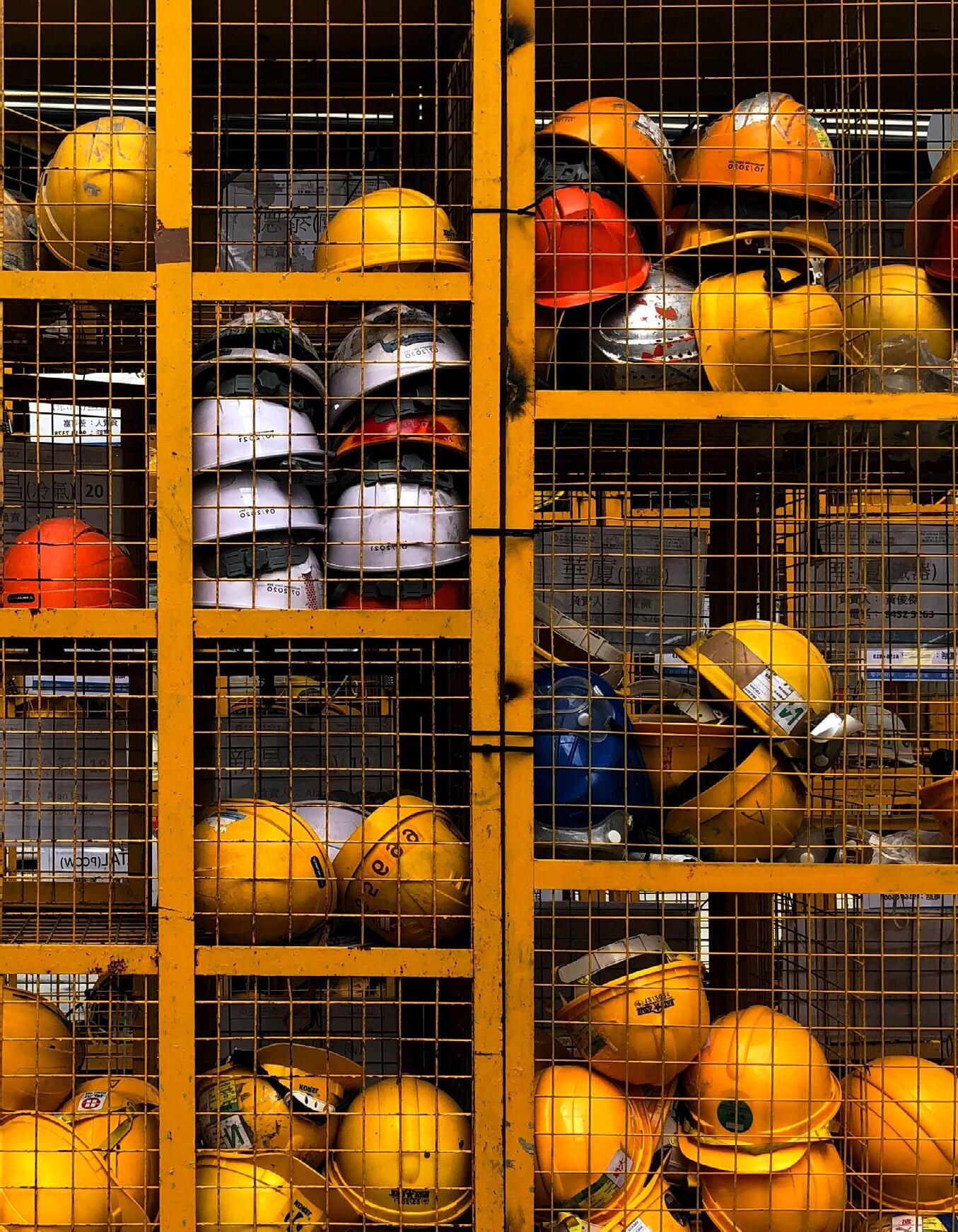
• the physical work environment, including lighting, ventilation, dust, heat and noise

• the psychological work environment, including overcrowding, deadlines, work arrangements (eg the effects of shift-work and overtime arrangements) and impairments that affect a person’s behaviour, such as work-related stress and fatigue, and drugs and alcohol.
PCBUs are responsible for providing and maintaining
safe plant and structures. This includes machinery, vehicles, vessels, aircraft, equipment (including personal protective equipment), appliances, containers, implements, tools, buildings, masts, towers, frameworks, pipelines, quarries, bridges, underground works (including shafts and tunnels) and any component of one of these items or anything fitted or connected to one of these items. PCBUs must also ensure the safe use, handling and storage of plant, structures and substances. Providing safe systems of work is also a PCBU’s responsibility, as is providing any information, training, instruction or supervision that is necessary to protect
all persons from risks to their health and safety which may arise from the work of the business.
It is also a PCBU’s job to monitor the health of workers and the conditions of the workplace.
Another responsibility of a PCBU is to provide adequate facilities for the welfare of workers when doing work for the business, including ensuring access to those facilities. This also applies to providing healthy and safe worker accommodation when appropriate.

Click here for more information.
PCBUs that fail to meet their health and safety obligations are putting people at risk and can face prosecution. The following are recent examples of health and safety failures by PCBUs and the resulting consequences.
Fine: $0 | Reparation: $110k | Max Fine: $500k
A district council has been sentenced for its part in the death of three-year old Lachlan Jones
WorkSafe New Zealand and Water Safety New Zealand are uniting to call for greater care around ponds, dams, and water bores, in light of new figures on drownings.
Since 2013, ponds, dams, and water bores have claimed the lives of 16 people across Aotearoa. Five of those were workplace fatalities, mostly on farms, however one victim was three-year old Lachlan Jones who was found in a Gore District Council wastewater pond.

The Council has been
sentenced for its part in the January 2019 death, for failing to design, install and maintain fencing to prevent children from accessing the ponds and to deter other members of the public from doing so.
“Lachlan’s death is a tragedy, and all of our thoughts are with his family. Although this occurred on council property, there are lessons for all businesses and organisations to heed,” says WorkSafe’s Head of Specialist Interventions, Dr Catherine Gardner.
“In particular, farms often
have water hazards which should be mapped out. These are workplaces, so think closely about fencing around play areas, animal pens, work areas and water spots.
“Although you may know where these hazards are and to be careful, not everybody who comes onto your site does and you are responsible for their safety,” says Gardner.
The youngest of the 16 pond drowning victims in the last decade was aged just 1.
“Tragically, Lachlan Jones
Fine: $0 |
is not alone in this grim tally. Half of these victims were children, which is eight young lives lost that could’ve been prevented,” says Water Safety New Zealand’s spokesperson, Gavin Walker.
“People don’t just drown at the beach, so those managing water hazards must take action to reduce the chance that another life is needlessly lost. Assume that anyone, including kids, will find their way to ponds, dams, or water bores on your site.”
Reparation: $62,185 | Max Fine: $1.5m
WorkSafe NZ is stressing the requirement for employers to provide and ensure personal protective equipment (PPE) is used after Northland business was found guilty and sentenced in relation to a casual worker in who suffered a significant eye injury
The victim and a supervisor were repairing orchard fencing in April 2021 when a high-tensile wire snapped, striking the 20-year-old’s left eye. The injury required two surgeries and his vision is now permanently impaired.
WorkSafe’s investigation into the incident found the business failed to train and supervise workers and didn’t monitor the safe use of PPE when workers were carrying out work. The business had no formal process in place to ensure workers
were wearing PPE, leaving supervisors to instead fill that gap by managing the wearing of PPE in the field. The investigation also found there had been a near miss one month earlier in similar circumstances, which was not reported to
senior management by a supervisor until after the later incident.
The victim, who was a trainee, had seen others including supervisors not using protective eyewear during fencing jobs and neither the victim nor their
supervisor had been wearing safety glasses at the time of the incident.
“Information about PPE such as eye protection and how it protects workers has been readily accessible for years now. The use of PPE is entrenched in every modern safe work practice. Businesses do not meet
their obligations to workers by viewing safety as optional, and workers should be wearing PPE where they are exposed to risk. Businesses are required to model and champion safe work.” says WorkSafe’s area investigation manager, Danielle Henry.
WorkSafe considered
the business had departed from guidance which was available and could have prevented this injury, including:
• Protecting your workers’ eyes
• Personal protective equipment guides for businesses and
Asbestos oversight a dangerous and expensive mishap
workers
• How to manage work risks
• Providing information, training, instruction or supervision for workers
Inspired Enterprises Limited (trading as Harrisons Carpet and Flooring Christchurch West)
Fine: $52.5k | Reparations: $0 | Max Fine: $500k
Fine: $1.1k | Reparations: $0k | Max Fine: $10k
Refurbishing comes with some very real risks as one business learned the hard way following a case of poorly handled flooring containing asbestos
Asbestos is a naturally occurring mineral containing strong fibres invisible to the eye. When asbestos is disturbed or removed, the fibres can become airborne and be inhaled, which can pose a significant health risk.
Inspired Enterprises
Limited, trading as Harrisons Carpet and Flooring Christchurch West, was hired to replace the flooring in a house in the suburb of Broomfield in June 2021.
A subcontractor, Lawrence Gannaway (trading as Simply Floors) uncovered old vinyl and disturbed its
backing during removal, then disposed of it in an unsafe way. Testing of the broken vinyl later returned a positive result for chrysotile asbestos.
Both Inspired Enterprises and its subcontractor Gannaway have now been sentenced in the Christ-
church District Court for health and safety failures. A WorkSafe investigation found neither identified at the outset that asbestos was likely to be disturbed. An asbestos management plan should have been in place but was not, and the customer’s quote made no
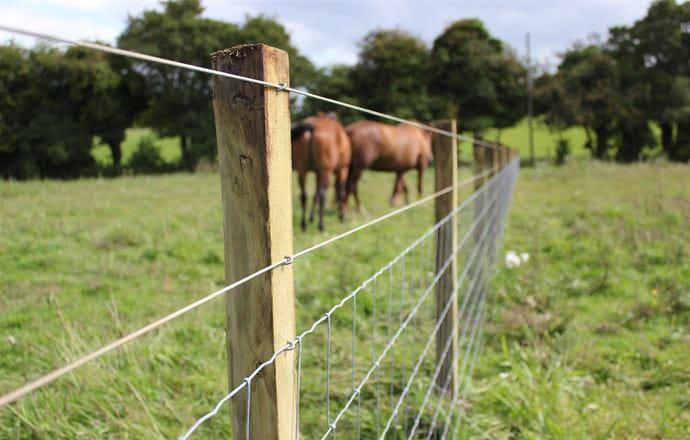
mention of asbestos.
“This unfortunate incident shows how even well-known operators like a Harrisons franchisee can be caught out on the basics of asbestos safety,” says WorkSafe’s General Inspectorate head, Simon Humphries.
Buildings constructed or renovated before 2000 are likely to contain asbestos materials.
“It’s not OK to assume there is no risk and you are in the clear. Businesses have a duty to identify and manage risks asso -
ciated with asbestos, and management plans are required for workplaces where asbestos or asbestos-containing material has been identified or is likely to be present. WorkSafe has comprehensive information on its website to help busi-

nesses and people understand the risks of asbestos and how to manage them,” says Humphries.
Read more about managing asbestos
Fine: $250k | Reparation: $100k | Max Fine: $1.5m
A Bay of Plenty business with an undocumented and ineffective health and safety process has been sentenced after a raised skip bin fell on a worker and inflicted a severe brain injury
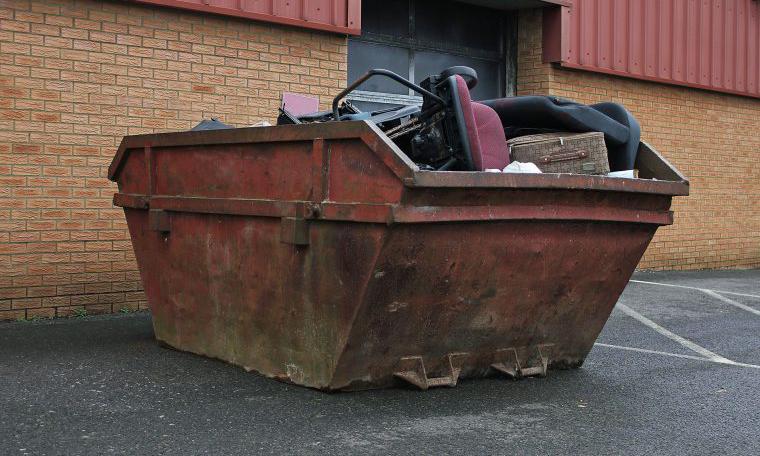
The victim, now 52 years old, was emptying the skip bin when it fell on his head and shoulders in March 2021. He later suffered several strokes in hospital and is likely to experience difficulties with his vision and swallowing food for the rest of his life.
The employer, Bin Boys Bay of Plenty, has been sentenced in the Tauranga District Court for health and safety failures that led to the incident. These include: failure to ensure that the
risks when loading, unloading, or tipping a skip bin were identified, assessed, and minimised.
failure to provide information and training for how to rig skip bins, and how to safely empty stuck material. failure to ensure that lifting equipment was installed, maintained, and used in line with best practice.
Bin Boys’ owners told WorkSafe its safety analysis for tipping bins was undocumented as it had been “mentally done”, and staff
were to “jiggle” skip bins by moving trucks back and forth to dislodge debris.
“Bin Boys relied on informal, on-the-job training to
satisfy itself that the victim, with no prior experience in similar work, was adequately trained and competent to do all parts of his role
unsupervised by half-way through his third day on the job,” says WorkSafe’s area investigation manager, Paul West.
“This approach to health and safety is completely
deficient, leading to tragic consequences and ultimately a loss of independence for the victim.
“Doing it right is not necessarily about creating paperwork, but about
ensuring existing staff have all they need to do the job safely, and getting new workers on the same page. Employers should strive to eliminate workplace risks, or put appropriate mea-
sures in place to mitigate them wherever possible,” says Paul West.
Fine: $265k |
Reparations: $271k | Max Fine: $1.5m
Inadequate training and supervision contributed to the death of a forestry technician in northern Hawke’s Bay, WorkSafe finds
The technician was repairing a mechanical attachment, known as a harvester head, when the device was activated by being manually spun. The 48-year-old was fatally crushed at Quail Ridge Forest in Putere, near Wairoa, in November 2020. The victim’s employer, Waratah Forestry Services Limited, pleaded guilty to health and safety failures and was sentenced recently.

WorkSafe identified that Waratah’s field technicians had been inadequately trained about the risks and controls involved in such a repair job, and weren’t properly monitored to correct any unsafe practices.
“Although the field technicians were provided with some safety instruction, the manuals for the harvester head were large and the ‘buddy’ training system the business had was insuffi-
cient. There was no other supervision and monitoring of the field technicians’ safety knowledge and practices,” says WorkSafe’s area investigation manager, Danielle Henry.
“Any business with field staff should stay on top of how those workers go about their job on an ongoing basis. It can be easy for safety to be compromised without workers necessarily realising it while they’re
working remotely, and employers need to be attuned to that risk.
“The victim was a muchloved father, husband, and brother. This is a particularly difficult time of year for his family to go through a court sentencing, and it’s important we recognise their loss as this case comes to a close today,” says Henry.
In 2020 Watercare initiated the Back 2 Basics programme to help reduce the number of preventable incidents across its construction sites.
Three years on, eight of Watercare’s construction partners are now rolling out the programme as a critical component of their on-site health and safety toolbox process across all Watercare construction sites.
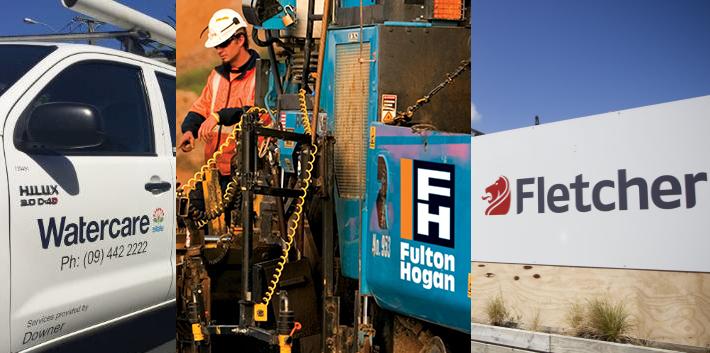
The programme makes health and safety everyone’s responsibility.
It was essential for us to create a programme that site managers could roll out at different times or frequencies and be led by our teams on the ground across various shifts.
For instance, a contractor working on one of our sites for a month would participate in a Back 2 Basics session each week as part of their induction.
The programme’s success lies in its ability to break embedded hierarchies that prevent people from speaking up about their experiences and health and safety concerns.
The Back 2 Basics programme encourages open dialogue, people to share their thoughts and life experiences, give feedback, and learn how to protect themselves and others on site better.
What’s great about the programme is it allows us to introduce health and safety modules that are more applicable to the environment they work in.
Fatigue training was rolled out across all Watercare sites in November.
The fatigue training focused on recognising the signs, taking practical steps to reduce fatigue, and sharing experiences or insights on the issue. It really helped to break down barriers even
The Back 2 Basics health and safety programme is being rolled out across all of Watercare’s construction sites after reducing the number of reported incidents, Watercare major projects engineering manager Craig Matthewson says
further.
Early in 2023, new resources will be rolled out, including posters in different languages as well as a booklet for new starters describing the various tools and materials used.
We have done this so that new people entering the workforce can have an easy reference guide as some people are unwilling to ask as they don’t want to look foolish in the eyes of their peers.
Watercare will give out the Back 2 Basics Health and Safety booklet to all contractors working on each site, and will be seeking feedback to make it as informative as possible.
As well as an overview of each module’s health and safety training, the booklet includes a glossary of common colloquialisms –and their definitions – that
people can expect to hear onsite.
The Back 2 Basics Health and Safety manual will be published in different languages to recognise the diversity of our skilled workforce across all our sites.
Watercare major projects general manager Richard McIntosh says the Back 2 Basics programme is all about keeping people safe by changing the culture around health and safety.
“We have seen our contractors come together and openly share their processes, learnings and ideas with each other.
“One of the biggest achievements we have made is getting genuine engagement across our site- based teams, who have stepped up to lead the cross-company worker engagement groups and are
unlocking some amazing initiatives and ideas.”
Fulton Hogan foreperson
Daniel Dennehy:
“What differentiates Back 2 Basics from other programmes is that it’s not the same “spiel” presented week after week.
“What stood out to me about the programme is that it required contractors and project managers working for competing companies to collaborate, share their learnings, and agree on a way forward.
“For many who attended the sessions, it opened their eyes to the hazards, such as blind spots and swing zones on machines. The sessions were highly applicable and practical to each site, so everyone took something away from each Back 2 Basics toolbox session.”
Bastion’s comprehensive range of barrier protection solutions are trusted widely by industry professionals throughout Australasia.
It’s a level of trust that has been achieved through consistent delivery of quality assurance over almost two decades in the industry.
When it comes to choosing suppliers, Bastion has a strict selection policy. They only work with internationally certified suppliers who
have strict quality control measures in place. For extra assurance Bastion regularly monitor their manufacturers’ production facilities and test quality control procedures through a third-party auditor.
Choosing the right suppliers is top of mind for Bastion, as it means
consistently delivering on their promise to protect New Zealanders with excellent quality product that is fit for purpose.
High stock levels & Specialist Team
Bastion is committed to maintaining high stock levels. With an extensive and well-resourced logistics
channel and strong supplier relationships, they are well positioned to keep customers stocked throughout the current global supply chain disruptions.
With just under twenty years of experience, Bastion are barrier protection specialists. Their experienced team provide expert support to help customers select products that are fit for purpose, fit correctly and are suited to specific industry applications.
Bastion Pacific NZ is a kiwi owned family business. Providing disposable barrier protection solutions, janitorial products and safety gloves to businesses throughout New Zealand and Australia.

If you’re not sure about a product, why not order a free sample?
Reach out to the Bastion team at enquiries@ bastionpacific.co.nz.

The major events of 2021-22, especially the dramatic impact of severe weather and our controversial prolonged Covid -19 national response affecting the social and political landscape are largely responsible for our faltering economy.
New Zealand’s 2022 economic and environmental travails continue to frustrate and confuse, imposing an enormous toll on communities and industry sectors alike.
After nearly three years, and despite new cases still in the thousands each week, Covid had disappeared from the public consciousness, replaced with more pressing concerns about inflation and the prospect of a deepening recession.

Adding to the escalating trials and tribulations of conducting a successful business are worsening skilled labour shortages, wage rises and falling performance standards in education and healthcare, compounding supply chain disruption continue to erode our productivity, economic prosperity and quality of life.
Throughout the past 15 months, New Zealand Inc continues to suffer economically, socially and emotionally. The extensive and repetitive damage and loss of life from extreme weather events is heart breaking, especially when emergency preparation and availability of the resources required to quickly respond, have been consistently found to be lacking.
Only the Military and Police personnel have the skills, together with vehicles and specialist equipment to operate in extreme conditions.
Scarce emergency bridging equipment must be hired by local councils and is commonly left in place for years.
In a country vulnerable to pandemics, natural disasters and increasingly violent weather events, sound emergency preparedness will always be a fundamental ‘bread and butter’ challenge to resolve. Instead, we struggle to overcome years of inaction and under investment to protect and sustain vital services.
Vulnerable communications, transport links, energy supply and an increasingly fragile
healthcare all require future proofing. It is not as if we lack collective experience, expertise and of course consultants.
What is seemingly too quickly forgotten and not comprehensively addressed are ‘lessons learned’ and implementing the consequential risk management required to prevent and mitigate reoccurrences.
Who isn’t aware our Healthcare professionals are united in pointing out the continuing deficiency in the face of more virulent Covid variants. Our admirable but under-strength national
and regional emergency responders lack experience and require world-class training and equipment.
The extreme weather of 2022/23 surely demonstrates the futility of relying on vital infrastructure increasingly at risk being restored to barely ‘fit for purpose ‘status.
No government can guarantee our roads, railways, bridging and interisland ferries capabilities will always survive increasingly unprecedented extremes of nature, especially earthquakes and flooding.
How many times will
As 2022 finally fades in the rear-view mirror, ending the plethora of analysis and commentary, we brace ourselves to negotiate a sadly familiar conglomeration of new and long-running challengesSupply chain disruption continues to erode productivity, economic prosperity and quality of life
we patch up increasingly vulnerable road and rail corridors before we prioritise the construction of more robust and efficient routes?
We can, and must, do a better job of building resilient infrastructure by implementing a long-term, bi-partisan strategy and capital works programme, featuring sound design, superior build and performance specifications and regular maintenance. This requires guaranteed funding and protection from short-term political influence in a multiyear rolling national infrastructure development programme requiring a public referendum to alter.
Repairing and replacing damaged homes and transport links will take years to be effective without skilled staff in sufficient numbers.
This highlights our controversial immigration policy as we struggle to recruit and retain the required professionals. Our fixing potholes and not the road does not ensure continuing work for a diminishing group of capable construction companies.
The recent huge auction of roading machinery from an insolvent major contractor graphically demonstrates the real cost of wasteful, piecemeal funding of the cheapest minimum
construction standard option, with subsequent massive cost over-runs and disruptive never-ending repairs.
Given New Zealand’s desultory performance in roading, and the inescapable fact roads will never go out of fashion, we need designs and build standards for robust, world class roads of national significance.
The progress
demonstrated by the skilled managers, artisans and contractors halfway through rebuilding the fire-stricken Notre Dame Cathedral in Paris in a mere four years are reportedly under budget and ahead of schedule.
New Zealand infrastructure planners take note? Countries build world class superhighways and other key infrastructure in years while we take decades.
Industry and the disrupted supply chain networks are adjusting to skilled labour shortages and fuel costs. They are now beset with fewer ship visits, exacerbated by the withdrawal of the Coastal
Comet service to five key ports and the continuing shortage of drivers. This chronic congestion and resulting inefficiencies and increased costs through stockpiling and expensive bulk chemical storage facilities.
A direct consequence is greater pressure on already damaged roads delaying efforts to improve productivity and reduce historically high inflation
We need a practiced, fully resourced national emergency preparedness capability.
But do not despair dear reader! There is a frisson of good news as 2022 is consigned to the history books and we focus on navigating the potholed landscape ahead.
Leapfrogging clearly less important legislation, the passing of the unheralded (but nonetheless welcome) Plain Language Act 2022 offers hope to beleaguered business operators struggling to interpret let alone comply with the unabated flow of regulations of dubious benefit and often contentious interpretation.
which is boosting our cost of living.
The likelihood is that extreme weather events will become more common. To implement key lessons from 2022 in 2023 and beyond requires a monumental change in our approach to meeting and exceeding critical infrastructure deficiencies.
It begins with the pan political, long-term commitment to invest in planning and constructing world-class solutions and a capable healthcare system able to mitigate the next pandemic together with resilient national road, rail and communication networks.
From April 2023, officialdom must jettison bureaucratic jargon in favour of clear, transparent and easily understood language when communicating with the public.
Given the heightened concern about the quality of our education system, another 535 communications staff in some major government agencies is the inevitable response.
Take care this year and do your best to avoid the potholes.
Barry Dyer is the Chief Executive of Responsible Care New Zealand (formerly the NZ Chemical Industry Council). One of 65 chemical associations worldwide implementing the UN endorsed Responsible Care® Safety, Health and Environmental Protection initiative, RCNZ provides a comprehensive range of unique products and services to encourage, enable and verify the safe management of hazardous substances and dangerous goods. These views are personal and not necessarily shared by Association members.

“Give us the tools and we will finish the job” –just much faster and certainly much Better.”
With apologies to Winston Churchill

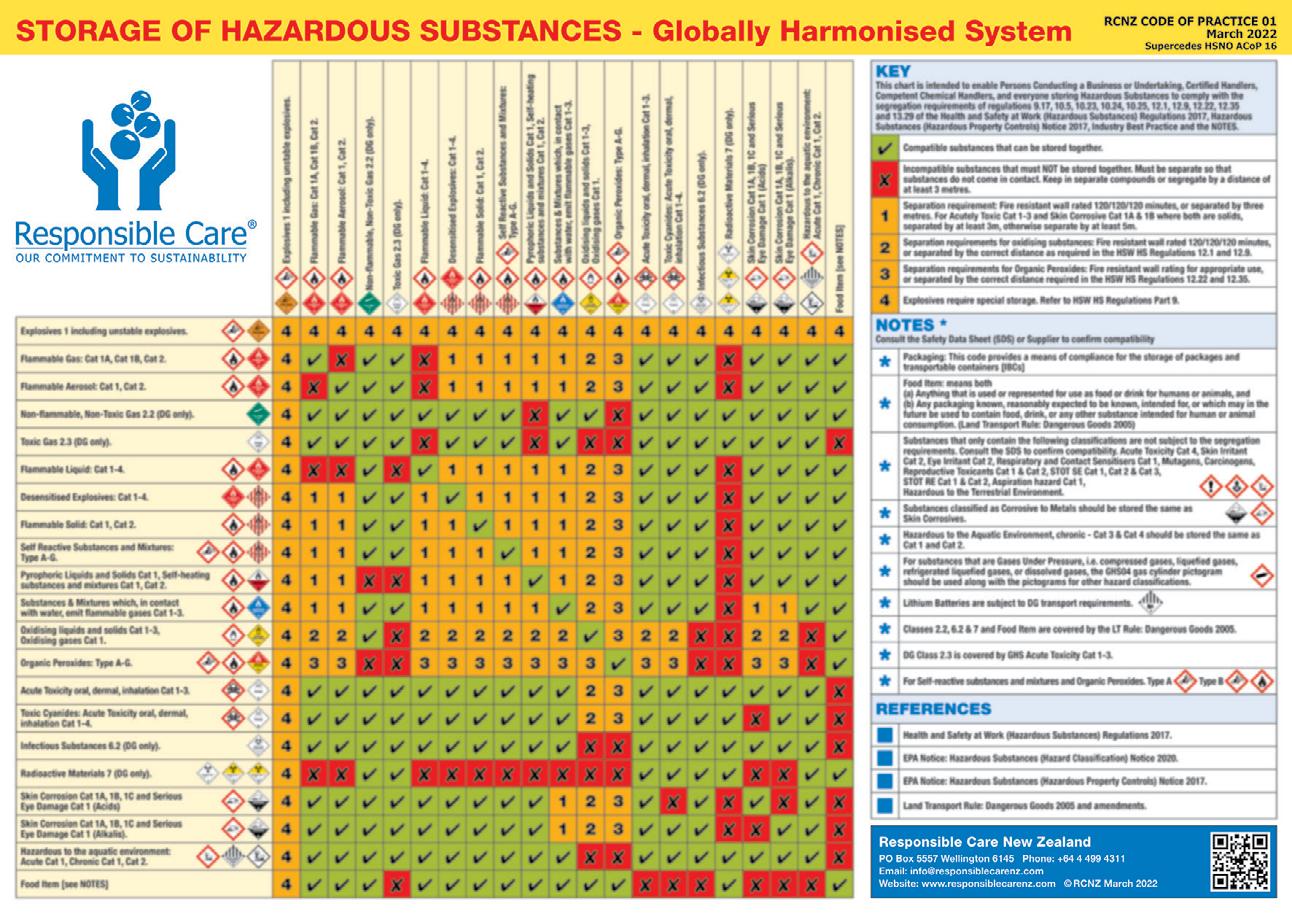

Increasing community concerns about vulnerability to unwanted chemical exposure and damage to our fragile environment places additional pressure on both suppliers and users of the chemicals.
We all need to sustain and improve our quality of life and these products must be safely managed throughout their life cycle.
places, by responding to workers’ suggestions about improvements.
Conscientious business operators can add value by sourcing accurate, cost-effective workplace chemical safety advice and compliance tools from their suppliers, industry partners and Responsible Care NZ.
However, they all obtain their chemical requirements from suppliers and can benefit from product stewardship advice and cost-effective industry compliance initiatives.
Today, chemical suppliers and their customers continue to adjust to the Covid operational environment.
They struggle with supply chain delays, the loss of experienced staff, frustration with unanswered queries to risk-averse authorities, inflexible and prescriptive regulations, rising compliance costs, diminishing resources and increasing public chemical safety expectations.
While 130,000 businesses are reportedly captured by the Hazardous Substances and Major Hazard Facilities regulations, the official mantra of “600-900 persons seriously harmed each year by unwanted exposure to chemicals in their workplace” presumably applies to all of the country’s 530,000 workplaces.
Downgrading the flawed but effective HSNO Certified Handler requirement has inadvertently undermined an invaluable capability.
The action deprived businesses, particularly SMEs, of an immediate and recognisable source of workplace chemical safety and compliance advice -- a safe chemical handling capability and emergency response knowledge – critical when a chemical incident occurs.
PCBUs and SMEs must now devise their own solutions to ensure employees are competent to safely handle the chemicals with which they work.
Chemical industry leaders are moving away from relying on lagging indicators of safety performance in favour of identifying safer work practices and work-
A proven strategy is government agencies collaborating with proactive industry associations to best achieve workplace safety aspirations. The problem is that SMEs rarely join associations.
Responsible Care NZ extols less regulation in favour of enabling business operators to be increasingly self-sufficient, using cost-effective products and services such as site compliance assessments and specialist training.
The focus is keeping people safe around the chemicals we encounter every day by adding value to businesses.
Chemical suppliers continue to help customers achieve workplace chemical safety aspirations through product stewardship initiatives.
To help solve the in-house chemical compliance dilemma in New Zealand, Responsible Care NZ delivers specialist and cost-effective Certified Handler standard training, complete with a certificate.
Responsible Care NZ site compliance assessments are non-threatening, effectively capturing and assessing chemical safety performance in a variety of workplaces. +64 4 499 4311


Dealing with extraordinary events is likely to cause some feelings of anxiety and distress – this is normal, MATES in Construction says
As we endure and begin to recover from such events, we want to remind everyone that if you are struggling or recognise that you are not travelling well, it is okay, because it’s okay NOT to be okay, but it’s NOT okay to do nothing about it.
1) De-stress
Go through the steps below to help you destress. This will give you the time and skills to manage your feelings and emotions more easily.
2) Step Back
Stop what you are doing, remove yourself from the situation immediately. This is for your own health and safety and the safety of others working around you.
3) Take a Breath
Take 10 seconds for yourself. Take a breath and breathe out slowly a few times this will help slow your heart rate and calm your busy mind.
4) Re-focus
Focus on the here and now and clear your mind
of the stressors you are feeling. Focusing is one of the best ways to alleviate stress by paying attention to what is going on now. This will help to calm your busy mind.
5) Engage
Now that you have had a few minutes to re-centre, what do you need to engage with from here?
• You might be OK. Carrying on with what you were doing might be OK for you.
• You might just need to chat to someone, talk to a
MATE, or family member.
• You might be struggling more than both of those options. If so, we recommend that you advise someone (a friend, a family member or colleague) and engage with more professional supports such as MATES in Construction on 0800 111 315.
mates.net.nz
Workers have a right to be kept safe and healthy, whether they are involved in cleaning up or clocking on for a shift. If it’s unsafe, speak up if you feel able to.
It’s a difficult time for many people and kōrero is important – workers should feel safe to raise concerns. Businesses and organisations should listen and do what they can to help, or explain what the plan is if it cannot be fixed straight away.
If you believe you or someone else is at risk of imminent harm you have the right to not do the unsafe work, but you need to let your employer know as soon as possible. You don’t have to restart the work until you believe that you are out of danger.
If you have a concern about unsafe work, notify WorkSafe.
Electricity and water is a dangerous combination. There are several things you can do to keep yourself and others safe:
• If you smell gas then vacate the area immediately. From a remote location, call the local gas company or supplier, or call 111 – so the source of the
gas can be found and fixed.
• Assume downed power lines are live and keep well away from them.
• If any electrical components (including plugs, sockets and charging equipment) have been wet, they need to be checked by an electrician for safety.
• If your house or workplace has been affected by water, turn the power off at the mains and get an electrician to check things out and disconnect any unsafe wiring before turning the power on again – if that can be done safely.
• If you need to use electrical equipment in a wet area, remember to use a safety switch (RCD) like you would when using appliances outdoors. Keep your hands dry when operating switches or
equipment.
• If circuit breakers have tripped, especially safety switches (RCDs), do not reset them until an electrician has checked them, otherwise you risk an electric shock.
• Pay attention to the safety of children, who are much more effected by electric shocks. In the event of an electric shock, no matter how minor, turn off the supply of electricity at the mains and do not turn it on again until it has been checked by an electrician. Keep the person well away from receiving another shock.
• EV chargers should not be used if they have been under water or exposed to water, get an electrician to check it out first.
• Battery powered equipment will not have an electric shock risk, but may pose a
fire risk. If batteries have been under water, get them checked by an electrician. Read more about managing health and safety
Read more about what to do after a flood

When homes and other buildings containing asbestos are damaged during floods, the asbestos-containing materials can become eroded, disturbed, broken, or friable. This can cause a health risk to homeowners, property owners, property managers, and the community.
When damaged asbestos-containing materials are wet, they are not as dangerous, but once dry they can cause a risk to health if fibres are released that can become airborne and be inhaled.
If the damaged structure is presumed to be asbestos-containing, a licenced asbestos assessor or licenced asbestos removalist should also be contacted prior to reoccupation.
Licence Holder Register
More information about asbestos | Ministry of Health
Recent flooding has highlighted the need for businesses and organisations to manage risks to make sure working conditions are safe, WorkSafe says
The Government announced a new visa to facilitate the availability of specialist migrant workers to help in the recovery efforts following Cyclone Gabrielle and other recent weather events in the North Island
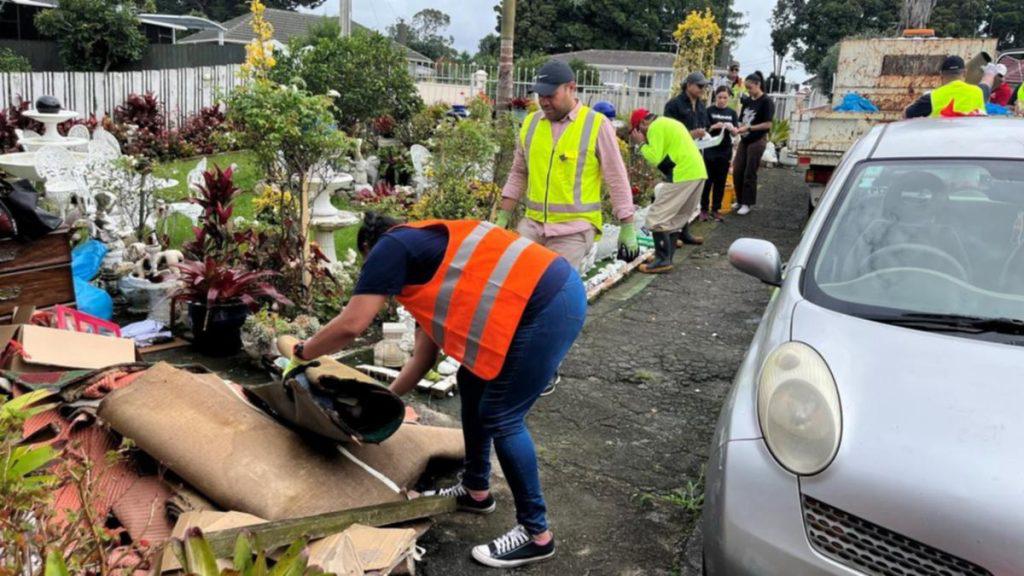
The Recovery Visa (a Specific Purpose Work Visa), will allow employers to sponsor migrants to come to New Zealand for a specific event or purpose, including working on an emergency response.
The full picture of labour demand is still emerging but we know that in the short term we’re going to need specialists from overseas such as engineers, technicians and insurance assessors to support our New Zealand experts on the ground.
INZ will aim to process
applications for the Recovery Visa within a week and many of them will be decided even quicker.
The initial visa will last up to 6 months. The $700 fee will be refunded for successful applicants. Similar pathways have been used for the responses to the Christchurch and Kaikoura earthquakes and insurance assessors have already been applying for Specific Purpose work visas after the first Auckland flooding event.
Employers wanting to recruit migrant workers for longer term roles are en-
couraged to use the existing Accredited Employer Work Visa. Changes are being considered to this visa to support faster processing for identified roles that will support the recovery and rebuild. These roles will be exempt from the labour market test.
Migrants already in New Zealand who need to change their role and location will be able to do so without breaching their visa conditions for up to 2 months – provided they stay with their same employer.
Migrants wanting to move
to another employer will still need to apply for a Job Change or Variation of Conditions.
Civil Contractors New Zealand Chief Executive Alan Pollard welcomes the changes, saying the new category was flexible and streamlined enough for the industry to recruit workers from overseas to work on the cyclone cleanup response, without the significant barriers that have prevented the industry from overcoming its critical shortage of workers.
“This visa category will enable the civil construction
industry to get the people it needs, without the burdens imposed by excessive cost, delay and red tape. It’s what our members need to be able to address the challenges posed by the cyclone.”
Pollard says while six months validity after issue was not a long time for the visa to be granted, he hoped the visa would be streamlined to connect in with other opportunities for migrants to support the country’s massive recovery build.
He says the country’s shortage of civil construc tion workers had been well-documented as the industry’s number one challenge for several years, and despite the industry’s efforts to create good train ing and workforce intake programmes, the inability to bring in migrant workers where needed had signifi cantly impacted projects and maintenance efforts.
While businesses had put a lot of energy into identi fying talent and developing people within New Zealand, they had at the same time been severely restricted by closed borders, a small pool of prospective workers and few infrastructure construc tion training opportunities, he says.
“It’s clear from the scale of this disaster that we have a lot of work to do. Civil construction companies are working hard to clean up debris and silt, as well as repair roads, public spaces and private properties. But they also need to look after their people, who can only work in ‘crisis mode’ for so long. New overseas workers will help spread the load.”
He says good mental health support was also needed to prevent fatigue and burnout amongst those working to repair the
damage wreaked by the cyclone, and encouraged companies to explore new crisis resources produced by MATES in Construction NZ.
The next step would be a co-ordinated international campaign to recruit top international talent that lev
This support can include:
• providing emergency response
• immediate clean-up
• assessing risk or loss
• infrastructure, building and housing stabilisation and/or repair
processing for identified roles that will support the recovery and rebuild. These roles will be exempt from the labour market test.
The Recovery Visa is not limited to roles in the North Island only, recognising that some direct support industries will be South
The Recovery Visa (a Specific Purpose Work Visa) allows employers to sponsor experts such as engineers, technicians, and insurance assessors to come to New Zealand.

The visa is for migrant workers coming to New Zealand for a short time (up to 6 months) to do a job that supports the North Island recovery from extreme weather events in January and February 2023.
This visa is not available to industries providing indirect support (e.g. businesses in the affected areas facing an increased demand for services) or to backfill vacancies of people leaving roles to work on the recovery. These employers will be able to access labour through other visas such as the Accredited Employer Work Visa (AEWV). Changes are being considered to the AEWV to support faster
Employer finds migrant workers who meet the requirements in assisting with the
Employer downloads and completes the Recovery Visa – Employer Supplementary Form (INZ 1377) and provides it to the
Migrant worker completes a Specific Purpose Work visa application, uploads/ attaches the Recovery Visa – Employer Supplementary Form (INZ 1377) and specifies length of stay in New Zealand as 6 months
Immigration New Zealand processes the application and provides the applicant
Recovery Visa – Employer Supplementary Form (INZ
INZ aims to process applications for the Recovery Visa within a week or less.
The NZD $700 fee will be refunded automatically for successful applicants. Refunds are expected to take 15 to 25 days to process, depending on demand for the new visa.
Worksafe NZ's Clean Air programme was their first targeted intervention on workrelated health. Their goal was to reduce the risk of respiratory ill-health caused by exposure to airborne contaminants in the workplace.
A key part of the programme is to raise awareness and eliminate or control the health risks of silica dust, organic solvents, welding fumes, wood dust, carbon monoxide and agrichemicals.
In New Zealand cancers and respiratory diseases from airborne substances account for at least 31% of total work-related harm and
an estimated 650 deaths per year. They account for 79% of the estimated 750 – 900 people who die annually from work-related health causes - Source: Worksafe NZ. More information here: https://www.worksafe.govt. nz/topic-and-industry/ work-relatedhealth/ carcinogens-and-airbornerisks/

Whether you are an employer who needs respiratory solutions for employees or a welder, plumber, spray painter, asbestos worker, farmer or even a casual carpenter – LUNG PROTECTION IS VITAL!
It is incumbent on PCBU’s
to ensure that workers are not exposed to carcinogens and airborne risks. When the hierarchy of controls in risk management have been applied and risks remain, Respiratory Protection Equipment is one of the last lines of defence.
Choosing the correct type of respiratory equipment can be quite confusing, but here are a few simple guidelines to ensure that employers and workplaces make the right decision.
• Get advice from experts.
• Use a reputable supplier.
• Ensure the respiratory equipment complies with AS/NZS1716:2012.
• Use the right filters or opt for an airline system if
necessary.
• Change filters regularly.
• Only use the filters supplied by the manufacturer of the respiratory mask to stay compliant.
• Get “fit tested”.
pH7 has the expertise and products to assist companies with their respiratory requirements. Follow pH7’s respiratory “fast facts” articles on LinkedIn, Facebook and Instagram for more insights.
For end to end solutions, contact us on 0800 323 223, email us at enquiries@ ph7.co.nz or go to www.pH7.co.nz
It is incumbent on PCBU’s to ensure that workers are not exposed to carcinogens and airborne risks
































